#for one ads for a while were an art form combining humor and creativity and plays for emotions
Explore tagged Tumblr posts
Text
.
#marketing makes me so sad these days#for one ads for a while were an art form combining humor and creativity and plays for emotions#it didnt matter if i didnt want the product sometimes the ads were fun enough on their own#or sometimes i did want that thing and would be reminded in a way that at least entertained me for a few minutes#but capitalism is just number go up#and despite research showing ad saturation has never driven sales and often sabotages them if over saturated#buy more ad is still number go up#i hate this fucking place
1 note
·
View note
Video
youtube
Limerick Surprise Like, Share, and Disc, we have something special in St...
Limericks, those short and witty verses understood for their funny twists, have a centuries-old heritage that continues to entertain individuals worldwide. Tracing back to the early 18th century, the origins of limericks are rooted in the Irish town of Limerick. It is believed that these funny poems were first promoted by the Maigue Poets, a group of talented writers associated with the town. The precise etymology of the word "limerick" remains unpredictable, yet there is consensus that the form gained its name due to its association with humorous rhymes originating from Limerick. These verses were typically recited in local bars, becoming popular entertainment. Their appealing rhythm and punchy humour caught the attention of poets and writers across the British Isles and beyond. At first, limericks consisted of 5 lines, following a particular AABBA rhyme pattern. The first two lines would develop a setting or introduce a character, leading to an amusing conclusion in the final line. These poems were typically spirited and absurd, employing wordplay and double meanings to develop humour. They were well-suited for oral storytelling and were typically shared and enjoyed in social settings. Limericks grew in appeal as time passed and discovered their way into various literature. Famous authors such as Edward Lear and Lewis Carroll, among others, contributed to their prominence with their own unique limerick compositions. Today, limericks continue to mesmerize readers with their creative wordplay and contagious rhythm, functioning as a testament to their long-lasting charm and the rich heritage from which they came. Crafting Consistent Quirks: How to Compose Limericks With their lively and rhythmic nature, Limericks have fascinated audiences for centuries. Whether you are a budding poet or just enjoy the charm of these creative verses, comprehending the art of limerick writing can help you unlock a world of creativity and wit. Crafting limericks needs attention to structure, rhythm, and rhyme. Let's look into the key elements that make a memorable limerick. Limericks are composed of five lines and have a unique rhyme plan called AABBA. The first, 2nd, and 5th lines all rhyme with one another, while the third and fourth lines have their own unique rhyming sound. This pattern differentiates limericks from other kinds of poetry and contributes to their unforgettable and musical nature. It is vital to preserve the consistent rhyme scheme to record the essence of a limerick and protect its appeal. The rhythm of a limerick is crucial to its efficiency, with the first, 2nd, and 5th lines usually having three stressed syllables and the third and fourth lines having 2. To develop a limerick with a lively and playful circulation, it is necessary to stress the stressed syllables and experiment with the musicality of the words. By having fun with the syllable tensions, you can create a vibrant and engaging rhythm that improves the general effect of the limerick. Limericks frequently incorporate humour, surprise, or a touch of irreverence, making them delightfully charming. They often include witty wordplay, unforeseen twists, or playful puns, adding cleverness and surprise to the verses. To produce limericks that mesmerize readers, attempt exploring non-traditional concepts, embracing wordplay, and letting your creativity cut loose. This will infuse your limericks with that evasive beauty that readers like. Laughing with Language: Checking Out the Playfulness of Limericks Worldwide poetry, limericks hold a special place for their distinct ability to combine humour, rhyme, and rhythm in simply a few brief lines. These spirited and frequently ridiculous verses have been capturing our creativities for centuries. Let's delve into the appeal of limericks and unravel the secrets behind their long-lasting popularity. Limericks are basically creative and entertaining poems that follow a specific pattern. They have 5 lines, with the first, second, and fifth lines sharing a rhyme and the third and fourth lines rhyming. This structure offers a structure for the playful use of language that limericks are popular for. Their brevity and wordplay make them an excellent means of comical expression. One of the defining features of limericks is their ability to shock the reader with unexpected twists or punchlines. These wonderful surprises typically develop from an abrupt shift in the poem's topic or the introduction of an unforeseen or unreasonable idea. This component of surprise and unpredictability contributes to the pleasure of reading and reciting limericks, making them a consistent source of laughter and amusement. Furthermore, limericks frequently use linguistic gadgets such as alliteration, onomatopoeia, and wordplay to enhance their comical effect. These imaginative language uses produce a wonderful interplay between sound and significance, raising the humorous effect of the verse. The mix of creative rhyme plans, unpredictable twists, and linguistic witticisms makes limericks an alluring form of entertainment, welcoming writers and readers to engage in the beautiful world of wordplay. Letting Loose the Funny Bone: Famous Limericks from History Limericks, those wonderful five-line poems, have been tickling our funny bones for centuries. Their unique rhyming scheme and witty material have become a staple in the world of humour. Here, we explore some of the most well-known limericks from history that have brought laughter to countless individuals.
safety first its not funny get your body cam for street protection at https://acticams.com
0 notes
Text
The Milky Way (1940)

"The Milky Way" is a beautiful little animated short from back in 1940. It was produced by Metro-Goldwyn-Mayer (MGM). MGM's animation department created a series called "Happy Harmonies," and "The Milky Way" is one of the cartoons from that series. The film was produced by Rudolf Ising and Hugh Harman - two animators who bounced around from studio to studio throughout the Golden Age of Animation. It has received an Academy Award nomination for Best Animated Short Subject in 1940, which is a testament to its artistic and technical achievements.
Technique
One of the most distinctive features of the production technique was the use of a multiplane camera. This camera allowed different layers of animation cels to be filmed at varying distances from the camera, creating a sense of depth and dimension in the animation. This technique made the animation appear more three-dimensional and added depth to the scenes, giving it a unique and visually appealing quality. This was a groundbreaking technique at the time and contributed to the film's acclaim. The use of depth and dimension in the animation was achieved through the skillful manipulation of multiplane cameras, which allowed for more complex and visually impressive scenes. The film was notable for its imaginative use of animation to bring celestial imagery to life. Fireflies in the night sky form constellations that tell stories, showcasing a creative approach to storytelling and animation. The film emphasized artistic craftsmanship, using hand-drawn animation and meticulous painting techniques to create visually stunning scenes. The attention to detail and artistic creativity made "The Milky Way" stand out as a visually captivating work of art. The final result was a fully animated short film that combined hand-drawn characters and backgrounds with innovative multiplane camera techniques to create the illusion of depth and dimension. This was a labor-intensive and artistic process that was the standard for animated films of that era.

Representation
Three tiny kittens, who were deprived of milk as a consequence of misplacing their mittens, embark on an adventure to the Milky Way in a hot air balloon. During their cosmic journey, they encounter various celestial wonders, such as a lunar surface resembling cheese, a high-speed comet train, a Mars that shoots stars, and the prominent constellations of the Big and Little Dipper. The narrative is rich in fantastical elements as the kittens journey to the Milky Way in a hot air balloon and encounter a series of playful and comical events in outer space. The story highlights themes of curiosity, escapism, and the world of dreams and imagination, where the boundaries of reality are blurred. It showcases the joy of exploration, the unexpected twists that can occur in a dreamlike setting, and the humorous consequences of their actions. Overall, the story is a creative and lighthearted tale that appeals to the imagination and sense of wonder.

Reception
"The Milky Way" was shown in theaters as a theatrical animated short, typically as part of a larger program that included feature films. During the era in which it was released (the Golden Age of Animation), animated shorts were a common feature before the main movie, and they were highly anticipated and well-received by audiences. At the time of its original release, "The Milky Way" was likely received positively by audiences. It was a part of MGM's animated short film series, and these shorts often featured imaginative storytelling, humor, and memorable characters. "The Milky Way," in particular, was a playful adaptation of the nursery rhyme "The Three Little Kittens," which was familiar to many, making it relatable and enjoyable for viewers.

Today, "The Milky Way" is recognized as a classic animated short from the Golden Age of Animation. While it may not have the same level of fame as some other animated characters like Tom and Jerry (which were also produced by MGM), it is appreciated by animation enthusiasts, historians, and those with an interest in vintage animation. The response to such classic animated shorts like "The Milky Way" today is generally positive, as they hold historical and artistic significance in the world of animation. They are valued for their nostalgia and as examples of the creativity and artistry of the time.
References
youtube
1 note
·
View note
Text
2020 Megaman Valentine’s Day Contest - Cat. 1 (Talent) Results!
Thank you to everyone again for your patience! This is getting posted way later than I wanted to. As much as I try to keep it short and sweet, I never do, so bear with my walls of text.
For the talent category this year, the theme was about killing Mega Man with kindness. More specifically, entrants had to create their own original love/Valentine’s-themed Robot Master or equivalent boss character that was created to defeat Mega Man with the power of love! Even though the theme title and concept alluded more to the classic Robot Master character contests, designs for any series were acceptable. But other than one Navi and one Reploid entry, everyone stuck to a Classic-series themed creation. So you were all pretty consistent!
There were a total of 16 entries for this category this year. Thank you all for your participation! It was extremely hard to choose winners for this category, because you all had really clever and creative concepts based off of this theme. So thank you for thinking up such clever and cool characters!!
Also thanks to Reploid 21XX for the coloring book prizes and for some additional insight.
Again, raffle prize winners will be contained in both posts, so keep an eye out between your name and your art. Not all raffle prize winners are contained in this post. I’ll be contacting all winners soon enough, so sit tight! Might be late after work tonight, so don’t panic if you don’t hear from me right after this is posted.
Your category winners and full gallery of entries are right here, after the break:
Category 1 (Talent) - Dr. Wily’s Greatest Creation: Killing Mega Man With Kindness
[Full Talent Gallery]
1.) @mo-sketchbook:
*For coming in 1st, mo-sketchbook has won $100 via Paypal, or a prize of their choice up to that value AND a Rockman 7 Coloring Book.*
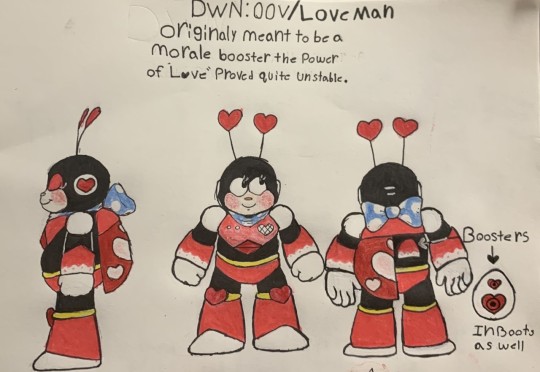

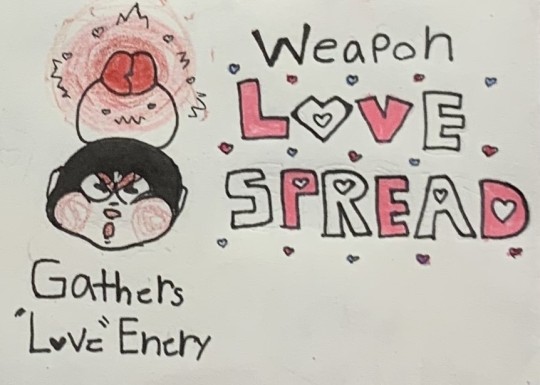

First and foremost, I appreciate all the effort you put into covering so many aspects of your creation, from the various design viewpoints, weapon get form for Mega Man, and showing the weapon in action. I really loved all the things you integrated into the design to give off the feeling that it is a love-based character. The “love bug” form, cherub-like Heat/Plug-type facial features, and how you utilized hearts in different ways for his design and powers.
I’m no Keiji Inafune, but I feel like this is a concept he would greenlight, in terms of it following his Robot Master design formula. It doesn’t need to be super detailed or flashy, but still fits the mold very well! The thought of the hearts missing their target and love energy then getting weaker is actually pretty clever, too. Cute, and I wuv it.
2.) @peachycircuits:
*For coming in 2nd, peachy has won $50 via Paypal, or a prize of their choice up to that value AND a Rockman 7 Coloring Book*


As usual, on the technical side of things, your art is one of the more polished and clean entries of the bunch. Combining a couple different aspects - swans as a creature known as a symbol of love, bonded for life like in marriage, and turning that into an inseparable pair of Robot Masters, was a clever way to think about your design, in terms of the theme of this category.
And then echoing that with the iconic Swan Lake, making them ballet dancers, is like taking Tundra Man and Gemini Man’s concept up another notch. Plus, not gonna lie, amused seeing Mega Man getting equipped with a tutu. LOL So even if it’s not as heart-themed as most of the other entries, I totally liked how you thought outside the box a little bit for this.
3.) Komito Amae:
*For coming in 3rd, Komito has won $25 via Paypal, or a prize of their choice up to that value*

I figured a cupid-styled arrow theme would pop up in a bunch of entries, but your Reploid, Beta, here caught my eye. Both in terms of the hearts, arrows and wings incorporated into her armor, and the pretty sweet looking buster that she and X both have equipped.
While I’m not sure how it would play out in the game, I think it would be interesting to suddenly take control of random enemies in a stage, and be able to change perspective as them for a short time, after you have shot them. Whether it would be to take out an enemy horde, or perform a task X can’t that the enemy could, it would be different! Can’t see it quite having the same powerful effect on a Maverick boss, but it’s certainly neat to think about how that could work!
And the rest of the wonderful entries, in alphabetical order by alias:
@autobot-bumblebee:
*Raffle Prize Winner* Dreamwave Comics: Issue 4 Page 15

I’m sorry you didn’t win a cash prize this time! Please don’t take me hostage! I totally loved the creative vintage chocolate factory mascot backstory, along with making your entry like an Ariga-styled character sheet page. Certainly get that retro feel with her clothing design. Her rose blade kinda reminds me of other hand-turned-blade-like-weapon characters, such as Alan Gabriel in the Big O or Ed transmuting one in FMA. Which is always a snazzy transformation for a robot!
@drewblossom:
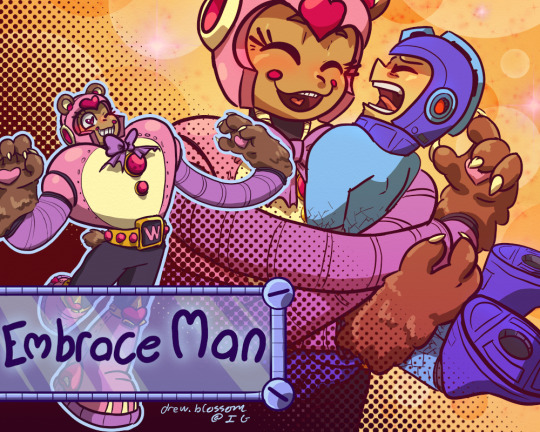
In all honesty, if I hadn’t placed you in the humor category, I think this would have very likely been somewhere in the top 3 for this category. A cuddly teddy bear with a massive Ariga-Quick Man-sized heart for a chest, extending flailing tube arms, who just wants to hug Mega Man to death is so amusing and awesome of a design. Hugs for everyone!
FluffyFrostyFury:
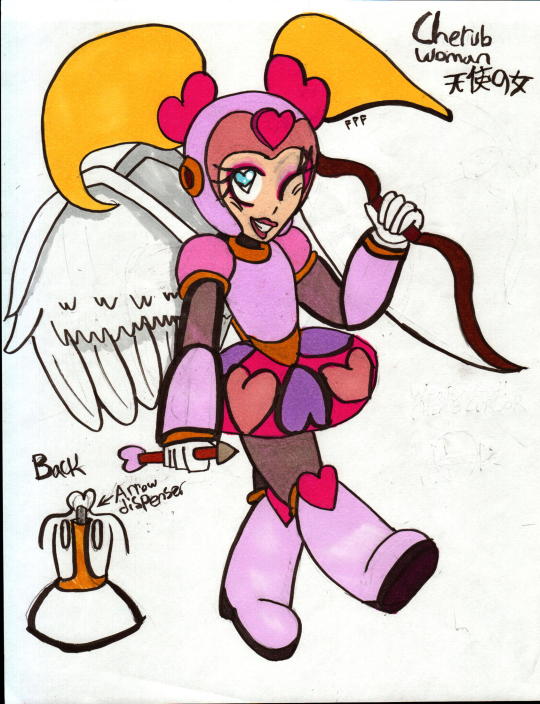
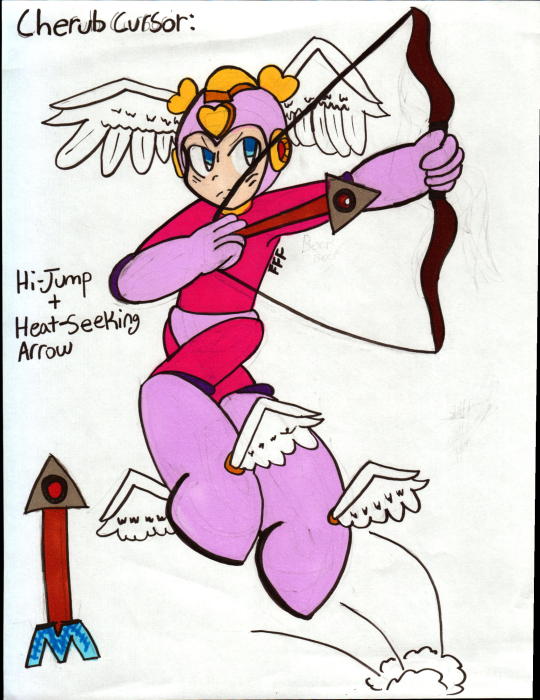
Your take of heat-seeking arrows and the added high jump powers were certainly a different take compared to the other cupid-styled creations. Definitely would be nice gameplay bonuses when equipped. I like how Mega Man also has the wings sprout out of his head, to mimic Cherub Woman’s pigtails, rather than the usual spot you would assume, on his back.
HealerCharm:
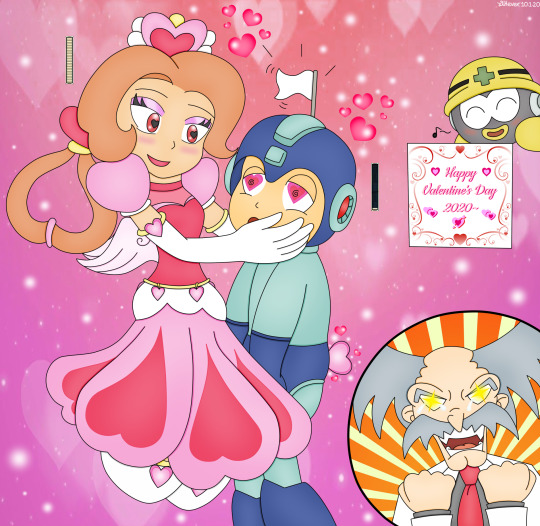
Hahaha, I love how your creation has caused Mega Man to wave the white flag after falling in love...wait, it isn’t White Day, and he should be giving her a gift if it was! XD Her hair tied up into a heart was a creative touch, much like how her dress flows into all those heart shapes. Adorable!
@inanehipsterslang:

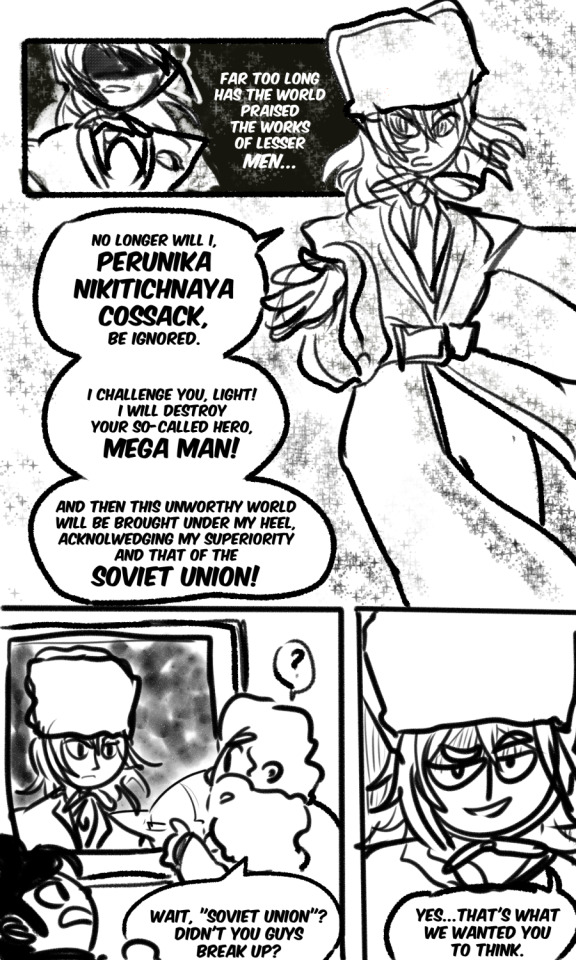
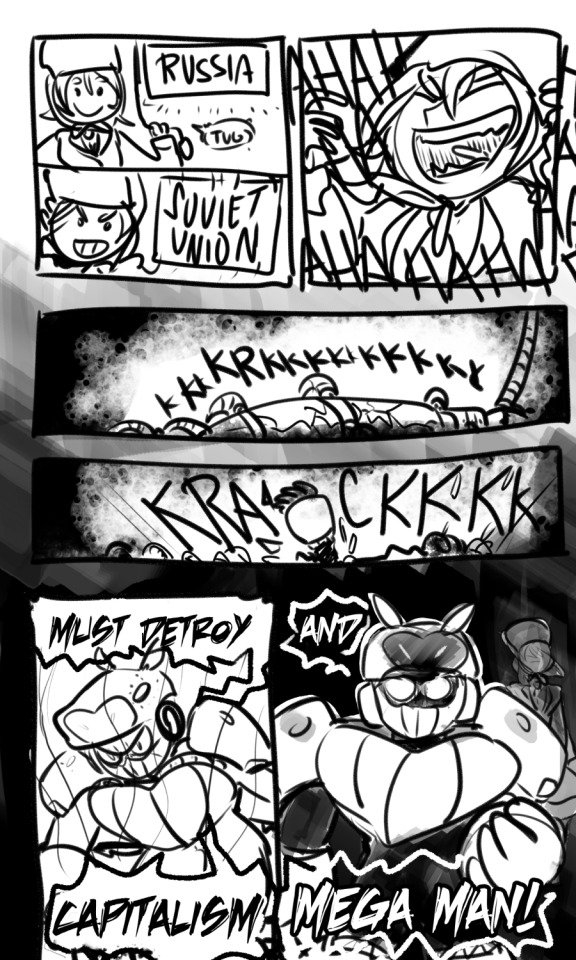
Um, can...can I count on you to vote for Bernie this election year?
Remember kids, it’s what’s on the inside that counts, looks don’t matter. Everyone deserves love, even those you consider ‘vermin.’ This was certainly an unexpected take on the theme, and gave me a good laugh, too. ‘Boiling-hot water...with a hint of citrus!’ It burns, but it smells so lemony-fresh!! XD But the two different moves fit together well, to protect and attack.
I like how you still incorporated a heart shape into Rodent Woman’s design with, both in her chest shape and the “nostril” area which is echoed in the Rodent Rover. And also props for giving her the non-armor form, unique compared to other entries.
Mattasaurs:

On the one hand, your design feels so different for a Robot Master, and maybe more Navi-like. But then I get the Astro/Galaxy-type eye vibe, and sort of a Plant Man~ish body with Devil hands feel, and see how it’d fit into Classic. It’s a unique look, and I liked it the more I inspected it. I really do love the idea of the heart bubble entrapping more and more enemies, and the big ol’ group hug ending up bursting their love bubble. It’s a different concept that stood out!
Minnie:
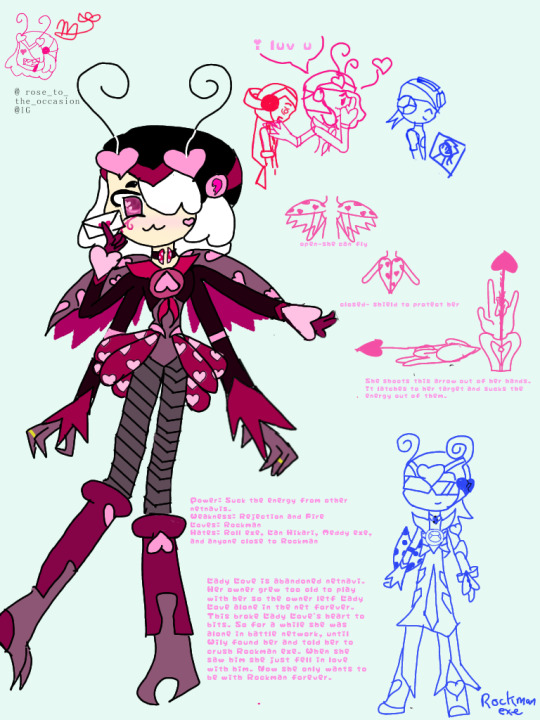
Our Navi of the bunch combined the love bug and cupid design, but your concept changed up the attack to suck out the energy of it’s target. Which almost made me think she should have an arrow-like mosquito nose, to feast on her target that way. XD I liked your wing shield concept and RiCO-styled skirt of hearts. Rock gets some cool shades in his Love Soul/Cross form, and I get the ProtoSoul vibe, with the shield transferring to his arm as well.
@pstart:
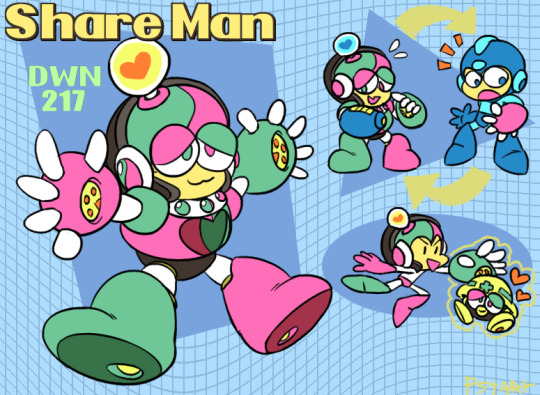
Another Heat/Plug-type design Share Man looks cute and sleepy, but is also “clumsy and weak.” His ability is to share body parts, so “the danger is in him sharing his less than ideal parts with his opponents.” It’s a totally neat concept, to see Mega Man lose his buster almost by accident, and now be powerless to stop Share Man. His split color scheme drives home the concept that his parts might not all be his own, and sort of a Frankenstein bot at times. Props to that idea!
While his weapon gives Mega Man the power to make enemies docile and sleepy, I really almost want to see Mega Man get dumb parts of enemies, too! Helmet switched to a Met helmet, Batton wings, a big Suzy eye! It’s now I’ve got your power...but...but what am I supposed to do with it? XD
RetroNinjin:
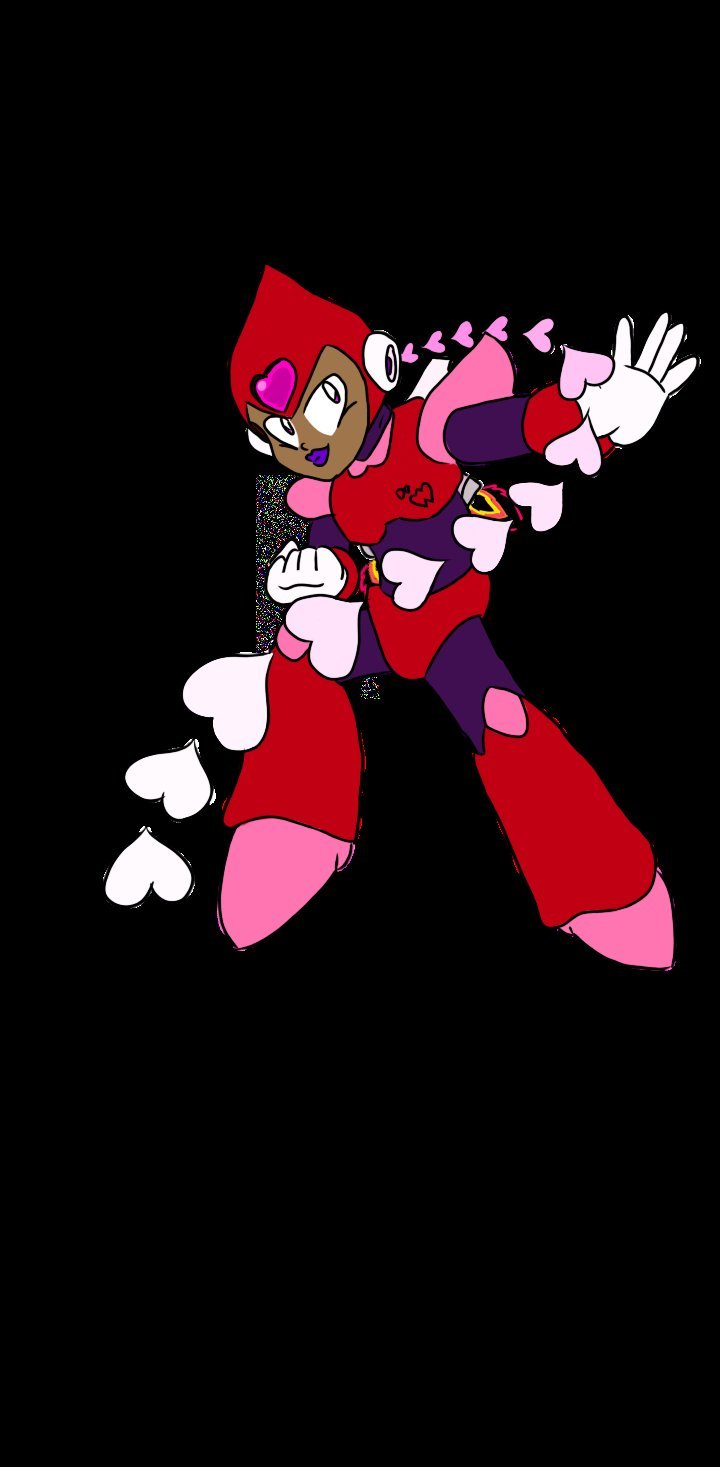
Unlike most others, your entry pushed the heart theme heavily in her armor design around the entire head and shoulder parts, so I definitely felt the love vibe. The color scheme fits well. Just would have liked to have had seen a little more information about her attack and concept.
RoninApprentice:
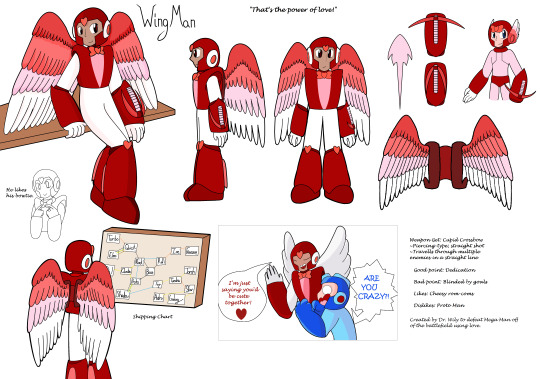
Mega Man having a “Wing Man” to set him up is a hilarious and clever idea! I give you kudos for thinking outside the box a bit on your concept and theme here. The shipping chart certainly drives the idea home, too. You still give him a classy/formal look, and keep the wing man aviation origin apparent in his attack style. Certainly a different idea having the heart bowtie transfer to Rock’s helmet in the form change, but it really doesn’t look that bad there, opposed to around his neck like it would be normally.
@star-crossed-swords:
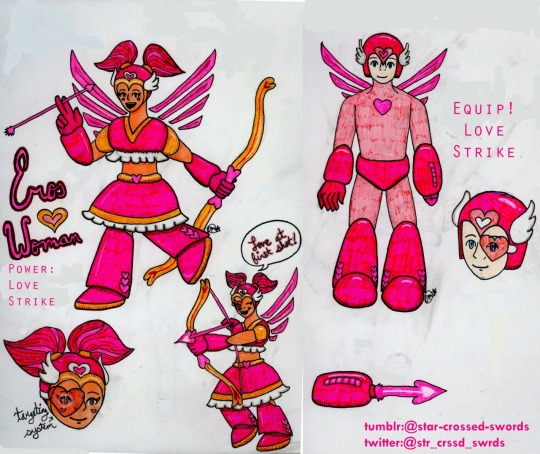
Different from the other cupid concepts, Eros Woman utilizes a Search-Man like targeting system to hit her targets. I like the heart scope addition over her and Rock’s eye when they go into firing mode. You took a different approach to the wing concept compared to others, echoing Cinnamon’s hairstyle in many respects. But it certainly fits with the rest of her design nicely, and looks good for Mega Man’s equipped form.
@star-shaped-soul:
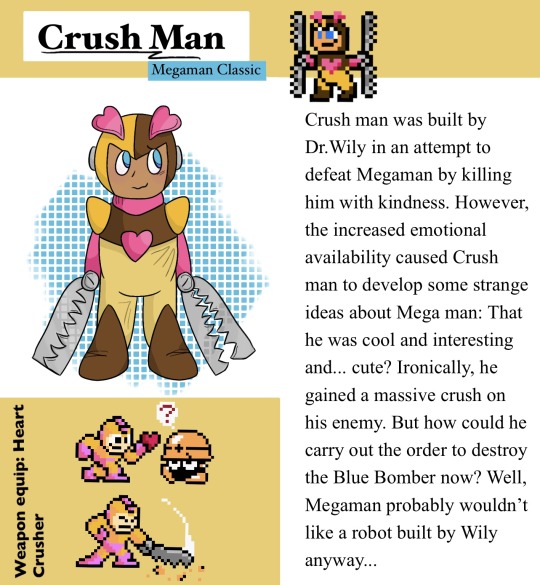
Love that you were able to both include a drawing and your own sprite, to mix in with the weapon equip ones. That is one powerful crush Mega Man has on his enemies now! I feel bad for Crush Man with how big and heavy those snare trap hands of his are. This seems like a Robot Master too cute for Wily to design; more like he stole him and added horrible, cruel hands onto him! This is taking a crush on someone to a whole different level! XD
Yuri Kadry:
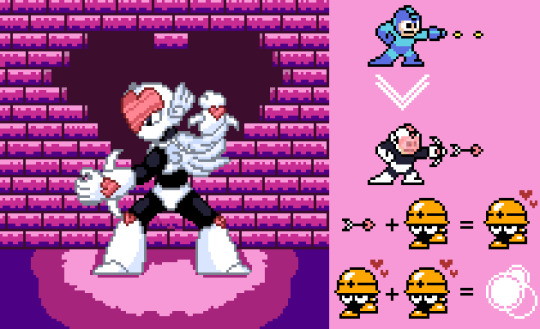
When equipped with Cupid Man’s power, I like the visor Mega Man gets. I think this is also a clever use of the weapon, having enemies shot attracted to one another, causing them to collide into each other. Well thought out! Love the original sprite art, and he stands out nicely against the pinks and purples in the background.
20 notes
·
View notes
Text
Why Craig McCracken is a Genius
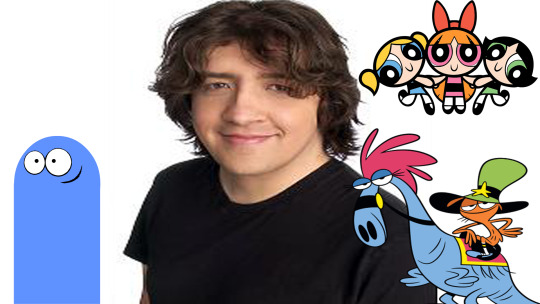
Anybody who follows my work as well as my most frequent postings and discussions knows that I LOVE animation. I sincerely and confidently say it is the greatest art form in the world, simply because in one way or another it’s every art form combined. It’s drawing, painting, acting, film making, special effects, literature and music all at the same time, and while cartoons get the unfortunate shove as being nothing more then non-intellectual “kid’s stuff”, the field has produced some of the finest achievements in art of the 20th century as well as the 21st so far. But much like any art form, the field is only as great as it’s artists and what they bring to the table. There are many great animators and animation directors that any enthusiast can point to for inspiration like Rebecca Sugar, Lauren Faust, Genndy Tartakovsky, Don Bluth, Tex Avery, Chuck Jones, Hayao Miyazaki, Sitoshi Kun, and of course the most obvious answer Walt Disney. While I have great admiration and nothing but respect for the artists above, I’d like to take a moment to appreciate the genius of the man behind the shows I bring with me throughout my childhood and even adult life. The creator of such shows as Powerpuff Girls (which incidentally he collaborated with Faust and Tartakovsky on), Foster’s Home for Imaginary Friends and Wander Over Yonder, Craig McCracken.
Make no mistake; there is a reason this man is so heavily respected and regarded in the current landscape of western animation, and you know a McCracken cartoon when you see them. But what exactly makes his work stand out? What is it about the cartoons McCracken has produced and directed that makes it so accessible to such a wide audience of kids and to an extent adults? How is it that whenever I put on an episode of Fosters or Wander Over Yonder I’m immediately put in a good mood and am enthusiastic about life? Well, after watching and studying his work I think I can boil it down to a few elements which, incidentally I’ve mentioned in previous blog posts before.
1. Beautifully Simple Character Design
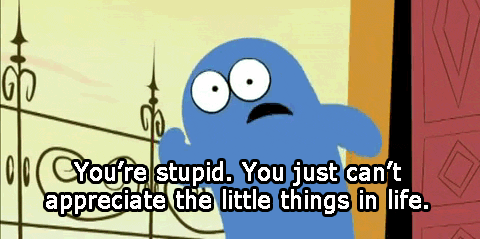
Aesthetically speaking, what do the Powerpuff Girls, Bloo from Fosters Home and Wander all have in common? The answer of course is that they are deceptively simple designs that all take a very minimalist approach. So many household names from cartoons are memorable but their designs can often be so complex that if one were to try and draw them from memory, even as a skilled cartoonist, they’d have just enough trouble that they may forget a few key aspects of the design. With McCracken’s designs you can draw them likely in less then 2 minutes, especially ol’ Bloo from Fosters Home. You just draw a little pac man ghost with little flipper arms, circular eyes, a grin and a straight line at the bottom and you’re done. One might think these designs are very limited because of how minimalist they are with how you can express them, and if you’re feeling particularly like a snobby Jackass you might call it lazy. But in truth these design choices are the most practical you can get as they give you all the essentials of the character with nothing superfluous. First, because of how quickly you can draw them by that very nature they are also SEVERAL times easier to animate, and with the added aid of glorious modern day technology (when it’s not crashing that is) producing high quality entertainment quickly has never been easier. Second, all the essential parts of the character are there. Each character in a show is a distinctive shape not replicated by any other character, meaning that if you were to put them in a silhouette you could easily recognize who is who. Also, the whole art of animation is expressing character and personality through motion, which is where the acting part of the field comes in. Just by mannerisms, typical distinctive poses and even the very nature of their walk cycles we know exactly what kind of person each character from these shows is. We know the Powerpuff Girls are only innocent on the surface level and in truth are actually quite violent and gruesome (unless you’re watching the new horrendous show that completely misses the point of what makes the original so great), we know Bloo from Foster’s Home is a mischievous egotistical little trickster who is always causing trouble and we know Wander is a happy go lucky optimist who only seeks to bring happiness to all. Sometimes the best way to go is to not think too hard about it and let the main points of the character come through with no additions holding them down or distracting from the point.
2. Creative Yet Broad Show Premises
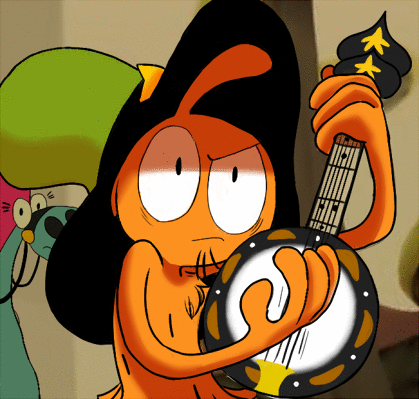
*This is my new favorite Gif*
I have to imagine each one of these shows had beautifully smooth pitches to get them funded (except maybe Powerpuff Girls because of the violence) because they have such imaginative and original premises that can be summed up so quickly to anyone who wants to watch and they leave themselves open to so many different types of stories.
*A boy visits his Imaginary Friend at a Foster Home where he and many other Imaginary Friends go on all sorts of hijinx or adventures, along the way saying goodbye to imaginary friends who find a new home*
or
*a superhero parody where a bunch of seemingly innocent and adorable little girls are actually quite violent and aggressive, and the show plays off of superhero stereotypes while also challenging typical gender roles*
Done. Great simple premise with unique concept not explored before. Take my money.
I’ve said before that it’s important for a show to have an easy to grasp premise, especially for children, because the easier it is to understand the more accessible it is to a larger audience. Plus because of the broad nature of the summary you can tell any kind of story you want between episodes. Premises like these have story ideas that just write themselves; it’s why the family sitcom of middle class family with idiot father and hot overcompensating wife exist, because everyone can relate to having a family and the dichotomy of a couple where one is the straight man putting up with the ceaseless antics of the other. Wander Over Yonder is a particularly good example of this because quite honestly all you need to know is “A couple of do-gooders wander the galaxy making new friends and incidentally run into an incompetent arch enemy a lot”. It’s basically just Road Runner but it takes place on a new planet every episode.
3. Color!!!!
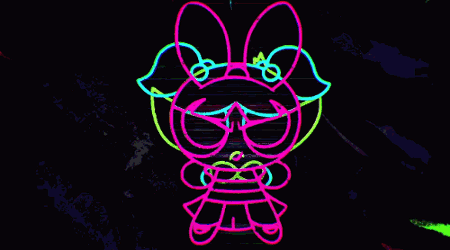
Craig McCracken KNOWS how to use color. It gives all of his shows such a warm inviting feeling because it’s all so bright and either blends nicely or makes decent contrast. This may seem like a minor point, but You’d be amazed how quickly a bad color palette can ruin a show for an audience. the color choices of these shows immediately attract the attention of the viewer with it’s positive vibes and satisfying placement. Plus each character has a color scheme appropriate to their personality (or more accurately they contrast, appropriating a common theme in McCracken’s work; polar opposites hanging out with each other). The goodhearted reasonable and well behaved Mac is red, but his mischievous trouble making fun loving imaginary friend Bloo is, well . . . . blue. The happy-go-lucky Wander is orange, but his logical and pragmatic best friend and steed Sylvia is blue. The leader Blossom is pink, the innocent Bubbles is baby blue and the tough tomboy Buttercup is green. They remain consistent with these choices and much like the contrast of these characters physical appearance it makes it all the more apparent that the characters themselves contrast too.I don’t know what else to say about it, but just TELL me you don’t watch the intro to Fosters Home and get all hyped up in the process!
https://www.youtube.com/watch?v=GZiB_S9VpiU
4. Surrealist Humor
One thing you’ll notice about these shows is that they aren’t afraid to be weird, Fosters especially. They take every chance they can get to have something surreal happen only to play it off moments later like it never happened. I think that’s always been a great strength of McCracken’s shows. A huge part of comedy is playing with expectations: nobody ever gets a laugh out of something predictable. But another great and common aspect of comedy is stark, jarring contrast. I once read a WONDERFUL book called The Humor Code by Joel Warner and Peter McGraw, that was all about studying what makes people laugh, and they brought up a theory in the book that comedy is all about violation + benign. Something is jarring to our senses but we quickly find out it’s actually nothing to be afraid of. Hence why being tickled by someone we love makes us laugh: it’s a violation of our personal space, but we know our loved one wouldn’t actually hurt us. But it wouldn’t be funny if we tickled ourselves because it’s not a violation, and it isn’t funny with someone you don’t trust tickles you because the violation isn’t benign. This can also happen in reverse: something that initially lowers our defences turns out to actually be harmful or annoying or bother us in some way. I’m not necessarily saying this is the be all and end all of comedy as it’s only a theory, but I think you could apply it to McCracken’s work. His cartoons are littered with moments where a character does something strange or random or out of the ordinary and nobody bats an eye, or maybe it’ll shift in perspective about how large the situation at hand is. An immediate example that comes to my mind is the episode of Wander where a planet is attacked on a huge scale by a destroyer of planets called “Buster” . . .which actually when you zoom out it turns out it’s an adorable little puppy just playing with a ball. Humor is largely subjective, but if you ask me . . that shit is funny.
https://www.youtube.com/watch?v=LZ5QRrAosQo
Conclusion
McCracken
has been making numerous contributions to the field of animation throughout his career and has gained notoriety for the shows under his belt . . and rightfully so. He understands pure and simple what cartoons are all about: simple, down to earth, easy to access entertainment that’s fun and leaves you in a good mood. Some television can be considered junk food like reality tv shows (cheap to produce, quick to make, advertised well but loaded with garbage), and others can be considered fruits and veggies like Breaking Bad or The Simpsons (they make you a better person and challenge your sensibilities), but sometimes all you really need is a light simple snack. One that’s colorful, sweet, and maybe even a little nutritious. McCracken delivers in his work with original premises, accessible characters, bright inviting colors and a delightfully weird sense of humor. God bless ya, Mr. McCracken!
#animation#Cartoon network#Disney#Cartoons#craig mccracken#powerpuff girls#fosters home for imaginary friends#wander over yonder#genius#animators#animators on tumblr#art#cartoon
220 notes
·
View notes
Text
Dive Into The World Of Kelly Dabbah Studios
Originally from the beautiful land of Switzerland, Kelly Dabbah now resides in the equally beautiful city of New York City. We discuss her upbringing, dreams, the difference between Miami art and New York art and SO much more. Kelly has a unique and authentic perspective on life and art. Her art will make you realize things you may have never thought of before. Kelly opens the door to creativity and expressive art to everyone.

Give us a glimpse into your childhood. What were you like as a kid?
I was born and raised in Geneva, Switzerland. My parents are from the Middle East and I have three sisters. Growing up with three sisters taught me a lot about girls but it also made me want to hang out with the boys more. I loved dressing like a girl but I felt more comfortable hanging out with boys. And that never changed.
As a child I was always sketching clothes, painting on silk and flipping through interior design magazines. It fulfilled and inspired me. Clothes always represented a way to express myself, a symbol against authority.
Have you always wanted to be an artist, or did you dream of something else?
I always defined myself as “outside the box.” I lived in my own world full of paint, crayons and odd clothing. My two passions have always been Fine Art and Fashion. I always knew that I wanted to be a creator, designer, and artist one day, but didn’t embrace it until my mid-20s. Now, I’m 28 and like feel I’m getting closer and closer to fully expressing myself as an artist.
I was always obsessed with the way clothes would embellish the woman’s body. Most of my drawings were and still are inspired by the curves of women. There was always a desire to combine Fashion and Art but I never felt the confidence to go for it until now.
My family put so much emphasis on having a conservative business education, rather than following your passions. I convinced myself that entering the fashion and art industry was a mere dream. So I put my passions to the side and aimed for a business education in Switzerland. I attended l’Ecole Hotelière de Lausanne and graduated with a Bachelors in Business Management and Hospitality. Even though my time in business school taught me invaluable business and life skills, I always felt incomplete as my creativity was sidelined.
Getting Into Fashion
My only creative outlet at this time was selecting what I wore every day. At this point, it was only a matter of finding the right opportunity to express my vision. It all happened in May 2014.
As a requirement of my undergrad, I had to work for a company of choice. In 2014, I applied to Chanel in New York. I was offered the job, and I excitedly packed my bags for New York. Throughout the experience, I was infatuated and inspired by everything surrounding me. I actually started to draw again. My ideas were flowing and I felt energized. I promised myself that from now on, I would only do what excites my soul.
While in NYC, I went to a Parsons information session and had an urge to enroll. After returning to Switzerland, I began taking technical and sketching lessons again. I knew I needed to build a portfolio if I wanted to return to Parsons. A year later there I was. Attending the school of my dreams, where I was taught everything about design.
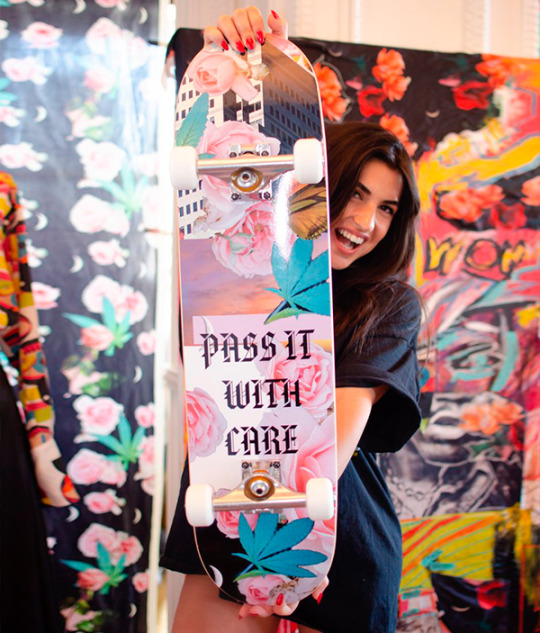
Take us through your creative process
I believe the creative process is part of your unconscious. It’s not something you can control or decide. It’s about being sensitive and aware of things that surround you. Like staring at people in the subway, seeing them talking, fighting, dancing, crying, etc. It’s very easy to get inspiration in NYC. All the city’s architecture, art, music, and design are very rich and influential. That’s the main reason why people come to NYC.
Personally, I try to surround myself with creative and positive people. For me, it’s something I try to maintain in my life. You can’t go further in life if you’re surrounded by close-minded people. Most of my friends are musicians and they have big dreams. When we hang, whether in a studio or at shows, it always gives me a lot of encouragement to chase my dreams. My friends have a huge impact on my creative process.
A lot of people get their inspiration from social media. It’s is a great platform where people can exchange ideas and get inspired. I follow lots of art magazines and interior design accounts that give me ideas and inspiration daily. I like to save them and stare at them a few days later and create a mood board.
It’s not about stealing ideas, it is about finding a starting point. I can get inspiration from a flower I saw in the deli or a picture of a flower on Pinterest. This same flower will give me the inspiration to create floral prints that are completely different from the flower I saw.
Is there a difference between Miami art and New York art?
They are very different. New York City is definitely richer in terms of museums, art galleries, artists, curators, etc. It’s a more saturated market. This can make it harder as an artist to get in touch with people because there’s so much talent.
Miami is very interesting for people like me who are just starting. It’s easier to get in touch with people in the art world and have projects going on. I think it’s a great place to get started since people are very open to collaboration and hearing your story. The Miami art scene is growing so fast, there are a lot of new opportunities and great projects to consider. There is a huge potential.
Do you prefer to work on large scale projects with a team or on smaller ones where it’s just you?
I love both. It’s important for me to have my own moment but it’s also important to have a team to work with on large scale projects. It’s like Ying and Yang. Having people helping me on my last large scale installation was amazing. They physically helped me with the whole set up and they gave me so much courage to continue when I felt low.
I love hearing other people’s opinions as long as I stay true to my own. Sometimes you have to take a step back and hear what other people think. We can get caught up in our world and need people to tell us what they think we should do. The creative process can make me feel lonely at times, having people around is essential for me.

Do you bring camp into your everyday life, or does it reside only in your art?
I always felt like my art is more kitsch than glamorous necessarily. There is no better way to process times of chaos and instability than through extreme art or fashion. It’s a fun form of escapism. I try to bring humor, colors, laughter, and extravagance into each aspect of my life. Humor is the answer, to everything, it helps you to move on.
Ironically, I don’t wear anything kitsch. Typically I just black clothes but I love to bring colorful furniture into my home. I love clothes and I always try my best to look good. So, in that sense, I’m bringing camp into my everyday life. My art reflects what is in my mind. I’m just a witness of a society where woman are becoming more powerful and more exuberant. Today it’s like sexuality has become almost ironic. Camp captures that spirit.
If you could switch lives with any artist, past or present, who would you choose?
Virgil Abloh for sure. He’s an artist but more than that a visionary and avant-garde, I love that. Abloh is someone who wears many hats. It’s awesome to have a vision and then apply it to different types of media. Doesn’t matter if it’s clothes, home decor, music or a lifestyle.
This guy doesn’t limit himself to one thing, he always pushes the boundaries. I admire him and look up to him in so many ways. There’s no doubt, he’s the king of collaborations. Abloh understands that he has an opportunity to change the scope of fashion.
One of my favorite quotes is:
“Fashion is art to me–I’m involved with all facets of art. My work in architecture, music, fashion, and my art exhibitions all work hand in hand and serve as an inspiration to one another. I see fashion and art as one great entity.”
Where do you think art will be in 50 years?
It’s hard to answer that question. I hope that art won’t be much different from what it is today. At the rate technology is changing, it will for sure have an influence on art. We might see more works with 3D projections on the wall or elaborate moving canvases that are already coming into play. I’m the first one to use digital software but I hope to still see authentic work on canvas that a lot of artists take months or years to create.
Is there anything you’re currently working on that you’d like to promote?
I recently added my work to Showfields in New York City and The Artpark in the Miami Design District. This summer, I’ll be releasing my skateboard art collection on kellydabbah.com, and collaborating with a few artists on an installation at the Delano Hotel in Miami. Soon, I’ll be launching my bathing suit line on my website, so be sure to watch for that.
Originally published on ARTRPRNR MGZN
0 notes
Text
This Month’s Reads - March
March got away from me, but I didn’t forget! Here’s this month’s reads.
highlights: We Were Eight Years in Power, Tash Hearts Tolstoy, Kase-san and Cherry Blossoms, Emergency Contact

[image description: the covers for the books listed below]
10 Dance vol 1 & 2 (Inouesatoh, translator: Karhys)
The sad truth is that most BL that makes it stateside is about students -- usually high school, sometimes college. So it’s always refreshing when something about Adults With Jobs gets translated. And as someone who is a passionate fan of sports/competition anime, I was especially excited to dig into this series about the world of ballroom dancing.
These two volumes are a strong start, although not exactly what I expected. It’s interesting to watch Sugiki and Suzuki dance around each other-- literally and figuratively. With their clashing personalities and styles, they definitely create a lot of friction and sparks with each other. Something about the pacing feels off to me though; I’ll be patient and keep reading to see how it develops.
We Were Eight Years in Power: An American Tragedy (Ta-Nehisi Coates)
Coates has been doing some of the most important writing of the last decade. I’d read a few of the articles collected in this book before, so some of the material was already familiar to me. However, his notes preceding each essay added an additional dimension to the contents. It was fascinating to see how his feelings had changed on the articles he’d written, as well as the subjects.
The Obama administration ran from age 16 to 24 for me, so a lot of how I perceive politics was shaped indirectly or directly by it. It was moving to read Coates’ thoughts both on the presidency and some of the biggest issues of modern times. In particular, “The Case for Reparations” should be required reading.

[image description: the covers for the books listed below]
Tash Hearts Tolstoy (Kathryn Ormsbee)
Tash is passionate about two things: Leo Tolstoy and directing. She’s combined her two interests into a single project, a low-budget web series adaptation of Anna Karenina. Suddenly it becomes hugely popular-- and that, of course, is when her troubles begin.
I picked up this book expecting to only relate to Tash’s asexuality. However, I surprised to see a lot of my teenage self in Tash’s struggles to continue her creative project as its audience swelled. What if people are disappointed with the next update? How do you handle having so many eyes on your work? I went through a similar experience in high school, though on a smaller scale. (For the record though, her asexuality was handled really well.)
What Makes You Beautiful (Bridget Liang)
This month’s transreading!
Total Eclipse of the Eternal Heart (Syundei, translator: Amber Tamosaitis)
Terumichi witnesses Yamada (the boy he’s crushing on) get brutally murdered. That’s bad enough, but then Yamada rises and walks away from the scene of the crime. It turns out that Yamada is the reincarnation of a murderer, cursed to be killed by the reincarnations of the nine boys he killed -- and Terumichi is one of them.
Total Eclipse has an intriguing premise, but the real horror of the story is the genuine love Terumichi/his past avatar had for Yamada/his past avatar. It’s grim, twisted tale about the terrible depths love can reach and how we can -- or can’t -- reconcile ourselves with those depths. I really wished the story had been at least 3 volumes instead of 1.

[image description: the covers for the books listed below]
Kase-san and Cherry Blossoms (Hiromi Takashima, translator: Jocelyne Allen)
Pleased to say that Kase-san and… continues to be one of the best yuri series currently coming out in the States. I was concerned that this would be the final volume, but it seems the series is ongoing? We might be in for a long wait until volume 6 though.
Yamada worries about getting into the university she’s aiming for. She wants to go to school in Tokyo, like Kase. Fortunately, Yamada does get into her chosen university and the couple continues their happy relationship in the big city. Since so much of yuri is confined to the high school years (with the implied “you’ll grow out of liking girls”), it’s an utter delight to see the couple taking this step forward together.
Emergency Contact (Mary H.K. Choi)
I checked this book out primarily because the cover design was so good and it paid me back well. With a strong sense of both character voice and setting, Emergency Contact rises above your typical “first semester of college” YA book. Penny and Sam both leap from page one as fully formed people, fleshed out with numerous quirks, flaws, and anxieties.
I related to both of the main character’s twisted relationships with their parents, as well as to the frustration that came with trying to work on their art while their life spiraled around them. Also, I really want to visit Austin now. Definitely worth reading if you’re into contemporary romances with a bit of bite to them.
Roadqueen: Eternal Roadtrip to Love (Mira Ong Chua)
Fake dating. Motorcycles. Lesbians. An absolutely ridiculous plot. I wasn’t expecting Roadqueen to be as silly as it was, but I’m glad it surprised me. While there is some genuine heart to the story and a few sad moments, this comic is primarily a campy romp.
Leo is popular with the girls, but more concerned with her motorcycle Bethany than committing to a relationship. Then the mysterious Vega shows up, steals Bethany, and tells Leo that she’ll return the bike if Leo can prove she is a “decent lesbian” within a week. I never really bought that Leo wanted a serious relationship with anyone, but it seems beside the point to question of the plot of something that’s clearly more about humor than logic.

[image description: the covers for the books listed below]
Shout Out Loud! 1 - 5 (Satosumi Takaguchi, translator: unlisted)
This month’s BL LookBack!
1 note
·
View note
Text
Optimisation is the enemy of creativity in marketing and music
No, you are not becoming crankier as you approach middle age – music is indeed getting worse every year. And the marketing industry’s obsession with optimisation is to blame.
In late 2017, the YouTube channel Thoughty2 published a video exploring how music has changed over the decades. After starting with The Beatles, the narrator continues with an example of classic British understatement: “Fast forward to 2010, when Justin Bieber released his hit single Baby. This is generally considered to be a bad move.”
According to the research in the video, lyrical intelligence, harmonic complexity, and timbral diversity have decreased while dynamic range compression has been used to make music louder and louder. In short, songs are becoming stupider – especially since every hit now includes the “millennial whoop” as well.
“Instead of experimenting with different musical techniques and instruments, the vast majority of pop music today is built using the exact same combination of keyboard, drum machine, sampler, and computer software,” Thoughty2’s narrator states. “This might be considered as progressive by some people, but it truth it sucks the creativity and originality out of music – making everything sound somewhat similar.”
As a rule, businesses do not like risk. The video states that record companies today must spend anywhere from $500,000 to $3m to sign and market a new artist. That is a lot of money to spend on a band without being fully confident of success.
To minimise the risk and maximise the potential return, these companies optimise the music to do whatever seems to have worked in the past. Same set of instruments? Check. Simple lyrics? Check. Is it loud? Check. Simple melody? Check. Can you dance to it? Check. Millennial whoop? Check check.
But that optimisation process is a downward spiral that will result only in songs that will make Rebecca Black’s Friday sound as brilliant as Led Zeppelin's Kashmir. It is creating music by paint-by-numbers. It is ticking boxes rather than being creative. And the same thing is occurring in the marketing industry today.
The rise of optimisation
After my first career in journalism years ago, I went into marketing and at one point met with a recruiter who was looking for a digital marketer. “I need an expert in SEO, ASO, and SMO,” she told me, further rattling off a lengthier list of random acronyms.
“Optimisation” became all the rage after companies discovered in the 2000s how much traffic websites could attract from search engines. After the birth of search engine optimisation (SEO), marketers tacked on the latter word to create “app store optimisation” and “social media optimisation” as well as countless other uses where the term also made little sense.
App store optimisation (ASO) looks for hacks to increase a mobile application’s ranking and findability in places such as the Google Play Store and Apple’s App Store – rather than, you know, creating and promoting a real, useful app that people will like. Social media optimisation (SMO) is a useless term because social media is simply a set of channels and tools that can be used for any specific promotion tactic.
Now, businesses have always discussed general best practices. My last job in journalism in the 2000s was serving as the editor-in-chief and executive director of the Boston non-profit newspaper Spare Change News. (It is one of the newspapers in the United States that are modeled on The Big Issue in the UK.)
In that role, I once attended an annual convention of the North American Street Newspaper Association that was held in Halifax, Canada. There, the assembled staffers discussed the best practices in terms of pricing, circulation, and countless other topics. Today, marketers talk about optimisation, which often means the best practices in line with someone else’s algorithms or what has purportedly worked for others.
Buffer has published studies on the ideal lengths of everything from blog posts to tweets to headlines to Facebook updates. HubSpot has reported the best times to post on social media. But in the end, both best practices and optimisation come down to the same thing: doing what everyone else is doing.
The perils of optimisation
Once, I was in a meeting where people were discussing how to get more traffic from blog posts spread on Facebook. The ideas focused on using psychology and gaming the social network’s algorithm: “Let’s ask people to comment on posts to increase engagement!” and “Let’s change the posts so that they are lists whose headlines start with numbers!”
“Make a funny, creative video advertisement instead,” I suggested, noting the reach that humorous videos receive on Facebook. But no one listened. Everyone cared so much about optimising the form of the creative that no one thought about the creativity of the creative. They prioritised the form over the function.
The perfect example of this is when marketers see studies on which headlines get the most “engagement.” In June 2017, Buzzsumo analysed 100m headlines and found this information on which headlines receive the most clicks, “likes,” and shares on Facebook:
Too many digital marketers use such information and focus on producing whatever marcom is cheapest and then optimising it. Here is a sample of recent blog posts on Medium from a certain prolific marketing writer:
5 Strange But True Habits of the World’s Richest People
5 Smart Reasons to Create Content Outside Your Niche
5 Simple Hacks to Sharpen Your Emotional Intelligence
10 Insanely Good Reasons You Should Publish On Medium
3 Unusual Hacks to Completely Up Your LinkedIn Game
Bored now.
Too many marketers go overboard and focus on optimisation to produce rubbish marketing such as clickbait blog posts with the same headline format such as this: [number] [unnecessarily strong adjective] [noun] to [achieve some goal].
The internet will continue to be flooded with boring, optimised posts that all have the same title formats in an effort to get clicks or satisfy other short-term metrics. But optimisation is the enemy of creativity and leads to worst long-term results. (Just look at how many reboots of successful TV shows from the 80s and 90s have failed today. The studios likely thought that copying what was done before would guarantee another success.)
Redundant optimisation quickly becomes cliched, hurts the brand, and is obvious to consumers. If Oxford Academic were to title journal articles in the above manner, the Oxford brand would become laughable. The only way for BuzzFeed News to be taken seriously – and the publication is indeed doing excellent journalism – has been to decouple its brand from the notoriously clickbait parent company.
Optimised reflects only short-term thinking. Using clickbait to get people to a website is the same as knocking people over the head and dragging them into your store. They may be there, but they will not buy anything because they will hate your brand.
When everyone optimises for everything, it is no longer a competitive advantage. The only true competitive advantage that people will have is what rests in their brains – creativity. Without that, you will only be as good as everyone else.
The benefits of creativity
According to an updated study in Admap magazine by Data2Decisions founder Paul Dyson, creativity is – by far – the second-best profit multiplier after market size:
Optimisation and best practices aim to do what someone else defines or the best of what everyone else does – but nothing more than that.
"Best practice is like training wheels – it keeps you safe whilst you're learning how to excel in your industry,” Helen Pollitt, head of SEO at the British digital marketing agency Reflect Digital, said. “To really differentiate yourself from the competition you need to be open to experimentation and growth, true optimisation requires facing failure. The issue with sticking to the safe zone of best practice is it stifles creativity."
The best depiction of the benefit of being different that I have seen comes from this BBH ad:
People notice what is different. And if your marketing does not get noticed in the first place, nothing else you do matters. As BBH London strategy director Lucian Trestler recently put it:
“‘Difference’ isn’t just a two bob philosophy or a frivolous creative penchant. It is the most powerful communications tool there is to deliver commercial results. We have a vast amount of data to support that. Evidence from neuroscience, marketing science and creative effectiveness data all agree on this point; difference is commercially safer than ‘safety.’”
Optimising based on data or algorithms is easier than being creative – but it is not always better, according to Wistia co-founder and chief executive Chris Savage.
“Today, everyone scores their leads with Marketo and A/B tests thirty different varieties of their landing page. You can’t get a competitive advantage doing that stuff anymore. You could say that as the percentage of marketers with a certain tech stack or using a certain tool approaches 100%, the competitive advantage you reap from it approaches zero,” he once wrote. "Using data to scale your marketing is critical. But when we all have access to the same types of data, it won’t be the data that differentiates us — it’ll be the art.”
Tom Goodwin recently said something similar: “A/B testing seems to be getting out of hand. Seems to be a way to offload decision making, not have a strategy, or gut or courage. What great art/music/products would ever be made this way?”
But tell that to those digital marketers who think only in terms of optimisation. Tell that to high-tech chief executives who want to mimic the marketing of competitors and think that they need only a differentiated product to be successful. (Just like record companies, startups are risk-averse because they do not want to lose the millions of investor dollars.)
In a quote attributed to John Ward from B&B Dorland in England, “advertising is a craft executed by people who aspire to be artists but is assessed by those who aspire to be scientists. I cannot imagine any human relationship more perfectly designed to produce total mayhem.”
At Digital Annexe University in 2015, Dave Trott gave a classic speech on creativity. Effective communications, he said, needs to have an impact, needs to communicate, and needs to be persuasive. “Impact” is the most important part.
“Impact will get you on the radar,” he said. “Without impact, there’s nothing there. There might be a bloke outside on the street right now telling us the secret of all life, and we’ll never know because we can’t hear him. Without impact, nothing happens.”
Now, take the desire of so many marketers to optimise all collateral to match some alleged universal standard. How will their work be different from that of everyone else? How will their work stand out? How will their work have an impact?
“Optimisation might work for certain businesses for a certain amount of time,” Steve Daniels, an independent graphic designer in the UK, said. “This course of action may feel safer, but it only remains safe if there are no competitors who disrupt the market or start playing the brand game in a strong way. As soon as that happens, focusing on creativity is a great a way to play the long game – and to invest in your future success.”
If your business wants to remain safe, no one will notice you. Taking creative risks is how you become memorable.
A quick recommendation
So, if you want to listen to an album where the musicians wrote their own material, played dozens of instruments, and created songs that are lyrically intelligent, harmonically complex, and timbrally diverse, I have an assignment for you.
Listen to records or remastered CDs of the Moody Blues album In Search of the Lost Chord (1968) and The Smiths’ song How Soon Is Now? (1985) with a good pair of noise-cancelling headphones and some refreshment of your choice. Maybe it will kickstart some creative inspiration.
After all, the Beatles will be remembered forever. Justin Bieber will not.
The Promotion Fix is an exclusive biweekly column for The Drum contributed by global marketing and technology keynote speaker Samuel Scott, a former journalist, consultant and director of marketing in the high-tech industry. Follow him on Twitter. Scott is based out of Tel Aviv, Israel.
This content was originally published here.
0 notes
Text
Illustration styles: definition and examples of this art
So, what is an illustration? And what are the illustration styles available?
Illustrations mean an artist interprets a text, or even social meaning, turning it into a drawing or painting.
This often means incorporating personality or humor.
An illustration is used to create emotion or give a message. It is expressive in style and doesn’t demand attention. Illustrations are used in books, magazines, advertisements, comic books, cartooning, fashion design, storyboards and video games. There is no single way of illustrating, and there are many illustration styles.
Illustration styles
Although there are many different styles of illustration, these may be categorized into the following groups:
Literal Illustrations
A literal illustration style depicts reality in a similar manner to non – fictional books. The picture depicts a credible scene, even while using fantasy or drama. Some examples of literal illustration include:
Photorealism – creating a photographic image
With photorealism, the artist uses a photograph as his source and creates a realistic replica in exquisite detail.
In photorealism, the artwork is often mistaken for a photograph. Drawing, perspective and color choice are crucial to this form of artwork. The artist often uses airbrushing, or hand-painting with acrylics or oils to achieve the final results.
Illustrations showing history or culture
This type of illustration is used to depict historical or cultural events. Often used by a culture to depict scenes or circumstances, this form of illustration can also be used even within an era of photography in order to depict mood or add a sense of drama.
Although sometimes used to flatter or degrade a culture or figure, these illustrations are realistic enough to be seen as literal images.
Hyperrealism – as close to reality as possible
This form of illustration tries to erase the line between art and reality and is seen to be an advancement on photorealism.
Sometimes extra features are added to a representation or an artist may work with monochrome pencils to create a social message. However, the goal is to create an image that is as close to reality as possible.
Conceptual Illustrations
Conceptual illustrations are metaphorical, with thought or imagery taking the place of realism. Although this work might contain elements of reality, the goal is to convey mood, metaphor, and subjectivity. This form of illustration By could be compared to fictional writing, where anything goes. Examples include:
Images in sequence
Images in sequence tell a story and can be used for cartoons, graphic novels, and even to plan movie scenes. Styles may differ, from quick sketches, to fineliner drawings with airbrushed detail. Depending on the message, an image may use crisp, clean colour, or may use ink, jagged lines, and a chaotic layout in order to depict the messy business of politics.
Information graphics
These are graphic representations of knowledge. They are often used to assist with understanding complex information.
While they show the audience what they are looking at, this is often represented in a way which contains additional insights. Some may look like literal illustration.
Abstract or distorted designs
An expressive form of illustration, removed from reality, where representations emerge from imagination. As it is so subjective, two abstract artworks will look very different to one another.
Freehand digital drawings or illustrations
In this type of illustration, the artist draws on a digital pad, allowing for smooth transitions between light and shadow. An artist can use layers of imagery to create complex backgrounds and add fine detail. Many of these images use raster (or dot) format, limiting the size they can be blown up to before losing quality.
Vector graphics and illustrations
With vector graphics, mathematical equations are used to produce designs. As vector diagrams don’t use strokes in the way freehand digital drawing does, the images are not as smooth as freehand designs. They can, however, be blown up without losing quality. These images have clear shapes and outlines and are very popular for web illustrations.
Children’s illustrations
Children’s illustrations tell a story or give a visual representation of a tale or even an imaginary being. The style of illustration depends on the age of the child. Some may be complex and realistic, while others may be naïve. Many children’s illustrations are colourful, and contain a lot of movement or activity. Characters are often bright, colourful and friendly.
Illustrations for commic books and graphic novels
Comic books or superheroes often involve characters in action. Styles are often complex and range from line drawings to airbrushed images. However, cartooning is often one of the most frequently used styles in comics.
Comic images often come in panels and often involve speech bubbles, or narratives. There may be words which combine with actions, such as POW! The size of panels, as well as how often they feature helps to set the pace of the story.
Book covers and publications
In many old books, such as those which focused on geography or natural history, illustrations were designed by hand and then reprinted. Now, however, book illustrations are designed in many different ways and then printed.
Illustrators are often used to design covers of books, in order to make them stand out in a bookshop. A cover often hints at what is inside the book and gives the idea of humor, seriousness, culture or movement.
Book illustrations range from cartoon style drawings to historical or cultural images. Although the saying ‘never judge a book by its cover’ is often repeated, it is actually the cover which will sell a book, and will assist the book with appealing to the correct audience.
Designs for logos or branding
Logos are a very specific style of illustration. Very often their goal is to give information about a product, using colour, font or imagery. Popular and easily recognizable logos include the Nike Swoosh or the Apple associated with Macintosh. Logos are often simple, but grab attention to a product, defining it as belonging to a particular brand.
Often this brand is associated with imagined qualities, such as speed, power or creativity, and the logo helps to conjure up this emotional message. Sometimes, businesses use more than simply a logo to assist with branding.
Many use mascots or images of their employees, in order to convey a message. This helps to transcend a product such as a shoe, and give it a deeper meaning in the minds of customers.
Tips to develop your illustration style
Using the internet, we are frequently introduced to illustrations in online news articles, the music we can download, comic books, adverts and even emails. This exposes us to a wide range of styles and is a good thing because it creates a wide range of examples to draw upon.
However, if you are bombarded with many good quality illustrations on a constant basis, how do you develop your own style? You Here are some tips:
Understand the underlying principles
While it is possible to learn illustration through practice, this often means imitating the styles of other illustrators who have already developed a style of their own. Unleashing your own creative potential is considerably more important so that you can build and grow, developing your own talents and sharing your own messages.
Without copying, you may be asking “What is an illustrator?” A formal education will teach you the underlying principles, motivations, and techniques of illustration so that you can use these building blocks to create your own designs.
As well as learning from those already within the field, you’ll learn the philosophies which will enable you to join in, expressing your own style as you do so.
Explore new illustration styles
If you feel stuck in a style rut, reproducing work you’ve been doing for a long time, you might want to pick up some new illustration styles or techniques, to develop your own work further.
However, remember that there is no reason to force yourself into uncomfortable spaces. If you feel stuck, or don’t enjoy the work you are trying out, remember that no artist is capable of doing everything, and if something doesn’t feel right, be prepared to move on.
Try new mediums
If you’re recognized for your pen drawings, how about giving acrylics a try? Switching the medium you use may give a new dimension to your work, focusing on a new atmosphere, colour or flare. If you already use multiple mediums, you could try textures, etching, stencils or even metallics.
You could change your format from small drawings to large canvases, or from large-scale paintings to comic books sized imagery. Even though your results may not be exceptional at first, exploring new mediums will bring you out of your style rut by taking you out of your comfort zone. Your experimentation will be worth it.
Be true to yourself
When defining your illustration style, don’t work on designing it around what is currently selling on the marketplace at the moment. Your first commission is a big achievement, and making money from art is rewarding.
However, share your own style in the marketplace so that you are able to develop your own artistic identity. As the market moves constantly, trying to copy or imitate current trends will leave you one step behind.
By developing your own style, you’ll be consistently working on your own techniques, improving and developing them, instead of remaining a second-rate version of illustrators you admire. Developing your own style means sharing your own meanings and bringing your own imagination into the foreground.
Without this, you won’t have the creative energy which will help to both define your work and keep you motivated. Without this, you risk losing your love of illustration.
Ending thoughts on illustration styles
There are many different illustration styles or techniques.
Some of them overlap.
However, understanding the different styles and the techniques they use gives you access to the principles behind each different design, enabling you to explore and expand on your illustration practice.
If you liked this article about illustration styles, you should check out these articles as well:
Face Cards: The Intricate Playing Card Designs
T-Shirt Design Ideas That Will Inspire You to Design a T-Shirt
Poster Printing: How To Print A Poster Flawlessly
The post Illustration styles: definition and examples of this art appeared first on Design your way.
from Web Development & Designing http://www.designyourway.net/blog/graphic-design/illustration-styles/
0 notes
Text
What’s Helping with My Depression Today?
9- 12- 17 -
One of my favorite ways to deal with depression, sometimes, is by treating it with love,.. The love of a lover, the love of deep, close friends,.. The love of animals, and the love of family. Childlike humor, lots of affection, oxytocin, the brain chemical of bonding and affection.
Lots of intensive time, nurturing and being cared for. Self love and self-hugs, self-holding (like the self-holding exercises of Peter Levine, which also look kind of similar to the self-reiki stuff you can do, and I just began doing these things without realizing they were the same kind of gestures as these exercises, and then I saw a picture and was like, hey! That’s what I’ve been doing. I don’t know,... Maybe I saw them before, and stored them in my subconscious and that’s where it came from, though I consciously had forgotten).
Getting good sleep. Also, a regular schedule and lots of sleep, like 7 or 8 hours or sometimes more, following my intuitive body feelings. Laying snuggled up with pillows, heavy blankets, weighted blankets, or other things that “hug” your body (such as therapeutic tools for autism and sensory processing disorder, like hammocks, things that squeeze, pressure and surround oneself, etc), because again, I think it must be about oxytocin and how to release it, and maybe it has something to do with my own sensory processing issues, in this case, too, sometimes. ...And, of course, eating well (this in particular deserves its own post, later), sleeping well.
Listening to music, all day. Maybe love songs, especially if there’s someone I’m feeling very fond of and in love with who I feel connected to, somehow (as happens often with me, and my astral lovers/spirit lovers,.. *sigh* Lol)... Music is supposed to release dopamine. So is talking to other people, and the feeling of that hit of attention when you are able to tell other people about what’s going on with you and get some feeling of recognition. I like to spend literally all day with people I feel really deeply care and love me, and with my daughter to watch all the time, I get to do that...
But I also like to spend time alone, with silence, and rest. Depending on how tired I am, that might be more important than music, or it goes through phases. The kind of music I listen to makes a big impact on my mood, and however I like modern music, I find that the best for lifting my mood often is the music of the 60s and 70s, like rock and soul is what I listen to. Sometimes reggae. Other kinds of music can help, too, like certain world drum music, for one. Gypsy music from Rajasthan and from Romania, Poland, and other places.
Cold showers, if I have the energy, which are said to release oxytocin and energize and stimulate the immune system, and help counter depression.
Along the lines of using speaking (and typing, sharing online too) to stimulate oxytocin, reading things that are interesting to me makes a big difference. I surf the web and certain favorite sites over and over, on depressive days, often, and it makes a big difference. Uplifting stuff, fascinating stuff, my favorite interests type of sites and such. But also imagery, that makes a big difference. I like the combination of imagery and words, which seem to give a double-effect, which complement each other, stimulating different parts of my mood and mind, perhaps. And I like to spend a bit of time reading, novels, particularly..
Not too much time,.. not too much focused mental activity and concentration, or that can worsen my depression, .. Maybe 20 to 30 minutes or maybe an hour or so of reading, usually works for me, per day. Something about words and creative thinking really seems to just spark me into a better state of mind, quite significantly, even though, as with most things I do, it’s small in itself.
But added with other things, it’s big. I have to have a whole diet of day long things, just like I do with the food and exercise and sunlight and other wellness things I do for my health.
Speaking of not overworking my mind and not overthinking, I find it really important to use my hands and body and give my mind a rest. Often this can make a big difference between recovering quickly or not. I find the things that make my hands feel this delicious kind of satisfied feeling. Crafts and just things to give my hands to do, something like anxiety or stress relieving stuff to do with my hands, and that gives them something to feel and this makes a big difference and I didn’t realize how much a difference it made, but then after reading a book about it, (’The Creativity Cure’, by Carrie and Alton Barron), a book I felt guided towards in the library, quite vividly, I tried it and realized, that, yes, this is really important and helpful. Also movement, moving the body, that helps.
Anything to quiet the mind, and have time to just let the mind wander or be still while you’re too busy with other things to really concentrate the mind. The use of the hands and the body and the quieting of the focused thought,.. These things let your mind rest and your subconscious be facilitated to come up with new perspectives and feel better about things and find solutions for what might have seemed overwhelming problems, oftentimes. It is totally vital and a big part of my day for me, now,..
But often, especially when I feel depressed, when I’ll often spend hours just not using my mind and just using my hands and body instead. If it can be creative that is often better, like crafts and art, because creativity is yet another way that the subconscious can tap into other solutions and work things out without you consciously realizing that you’re even doing that. But meditative motion, like dancing, works for this, too,.. Not just art and tactile productive crafts.
When I am depressed I don’t always feel most creative and so things that aren’t even that creative can often still help,... And I find that when my own mind and creativity take the back seat, I can sometimes let spirit channel creativity for me, instead, and come up with some amazing things by letting my intuition guide instead of my own creative taste and feelings and impulses. Where does this intuition come from? I don’t know, it’s hard to describe. Maybe I’ll elaborate on it more, later.
Then speaking of not using the mind too much, of course, meditativeness and meditation works wonders for me too.
But if I’m not in the meditative state of mind, because, say, it will bring up too much painful noise and agitation with no solution and no calm to be found in trying to meditate... When depressed I am not up to dealing with that and so,...
Then, contemplation,... asking problems or questions, to the universe, to my higher self, untangling it and untangling it till I find an answer, or even just laying it out there and then letting it go, turning to a new direction,... And, or divination, often alongside the contemplation.
These make a big impact on me. Or listening to music and contemplating the lyrics of the songs, like a form of meditative divination, but not taking it too seriously.. And this again employs the verbal brain and the benefits from listening to music.
And, just resting,.. Resting, resting.. No thought, no movement,.. Often that is best, just laying there, meditatively, in the dark, at night,.. Or in the day. Often that resets me best, but it depends because of course, too much rest is not good for too long, either. Movement and mental movement keep one feeling alive.
Affection, joy and interaction and purpose and so on, they can keep one feeling alive in heart. But so often I find that depression, for me, has something to do with being really worn out, at some level of my being, and a few hours here and there of just laying around, doing nothing, peacefully, can make a big difference in how I feel. Maybe even a whole day of that, sometimes can push me over the hurdle to the other side,.. But especially if I can spend that day of rest doing other things that make me well, even while resting.. Such as some of the other things I mentioned here.
Sunlight and exercise are necessary elements of my daily life too, and nature, too.. Not just sunlight. It makes such a really tremendous impact on me, and I wonder if that alone is one of the primary reasons that I’m so much less depressed than I used to be, before we moved where we live now. Before, we didn’t get out every day and I didn’t get sunlight every day, and I get way more exercise now, even though it’s only walking, but walking 30 minutes to a few hours most days.
And the nature, I can’t describe how it somehow puts my mind and senses and perspectives and understanding in order. It somehow drains away my stress and upset and infuses me with answers and well being, calm and happiness, and a sense of “what was I so upset about, anyway”, somehow... Even though, of course, it doesn’t always work that dramatically, and I still have problems left over on my worst days, and still feel down, but it’s again, one of those small things that’s far bigger than it seems, and, so when combined with the other things, it’s really so.
Allergies really worsen my depression, nasal allergies and food allergies. Even though I can’t always control those things, it helps me to realize what is happening to me, because then I can see that no, it’s not like I have a reason to feel distressed, this is just my body fooling me into thinking maybe things are far worse than they really are, so that gives me a little more ability to let it go and stay more detached from it all.
And, that’s just a beginning. Some of what’s helping me, today.
I’d like to list all the things, organized by category, elaborated with specific tools and steps and resources, ranked by what helps most, and maybe for some, what helps most with certain kinds of depression and other symptoms and other mental health conditions that can respond to the same kind of practices.
I’d like to share more of what helps me, too, but I think it’s good to break it up a little, and I have written a fair chunk here.
Maybe I’ll come back and write more later. Tonight or tomorrow.
My cat woke me up and wouldn’t leave me alone so I decided to post some midnight rambles when I actually can hear myself think tonight. My cat, my familiar, I think of him, and he often guides me and helps me, even through annoying means like not letting me sleep... Maybe it was the right time to write all this, as it really does seem to be flowing more than it usually does, so cool that is!
#depression#core practices for coping with depression#little things that help with depression#posts to elaborate on
0 notes
Text
Webcomic Whimsy: Parhelion
Welcome to the Woohooligan Weekly Webcomic Whimsy! I've given a couple of interviews in the past, but this is my first experience with reviewing. If you have any suggestions for improvements, feel free to leave a note. If you're a webcomic author and would like a review, you can see my announcement and review rules here.
Title: Parhelion
Author: Riley Smith • Twitter • Tumblr
Site: ParhelionComic.com • Patreon
Genres: Experimental, Dystopian, SciFi, Space Opera, Black Comedy, Experimental, Surreal, Action/Adventure, Gay Space Pirates, A day in the life of a bargain-bin Han Solo
Rating: PG, T for Teen - adult situations, some language
Updates: ??
Synopsis: (from ParhelionComic.com/about) - The World’s Collective, an ambitious plan to unite the galaxy, has just formally collapsed. A despondent interpreter hires a pirate to retrieve some personal files from his office, and they hit it off. Meanwhile, wheels are turning throughout the galaxy, with all kinds of plans at cross-purposes. Warlords lock horns, Boltzmann Brains fight for freedom, and plenty of people just want some peace and quiet.
The first thing anyone is bound to notice about Parhelion is its experimental art style. I suspect this will be a case of "love it or hate it" with very few people in the undecided camp. It certainly has its appeal, with a kind of "baroque simplicity", (which in English means it looks more complicated than it is). Although later chapters get some monochromatic coloring, there's never full color and it might be better that way. Even when a character is human, the lines of the form often don't intersect, leaving a gap at a joint like a waist or elbow, so full color might look out of place. With alien characters, all bets are off, as there's barely a passing nod to notions of anatomy. One drawback to this style is the ambassador from the Planet of the Floor Lamps! (See, it's like Planet of the Apes but...)
A small side-note: so far, Riley is the only author I've reviewed who maintains an annotated synopsis of all his chapters. It's a nice touch if you'd like to see the whole outline of the story in advance.
If you don't mind an occasional character who looks like office furniture, there's a dystopian space opera here that you might enjoy, hot on the heels of a failed galactic government called the Collective. The first page opens with, "like it or not, civilization is built on stimulants, pornography and worse." I'm not sure if the author thinks poorly of porn or if they expect the reader to. I personally think porn is like other industries, there's some bad stuff to be had, but there are also unscrupulous insurance people making money off of the death or misfortune of others. So I won't personally single-out the porn industry as "bad stuff", and stimulants? Meh... coffee is a stimulant. But if you're expecting any porn in this comic, remember that any dick picks will inevitably look like a Tinkertoy with this style of art. (There isn't any porn, it's T for Teen.)
But I digress... that opening line is intended to set the mood of Parhelion's dystopian future. The main character, Peter, is jaded while not being entirely cynical, describing the recently collapsed Collective as "a beacon of hope, smothered at birth by a pack of vultures."
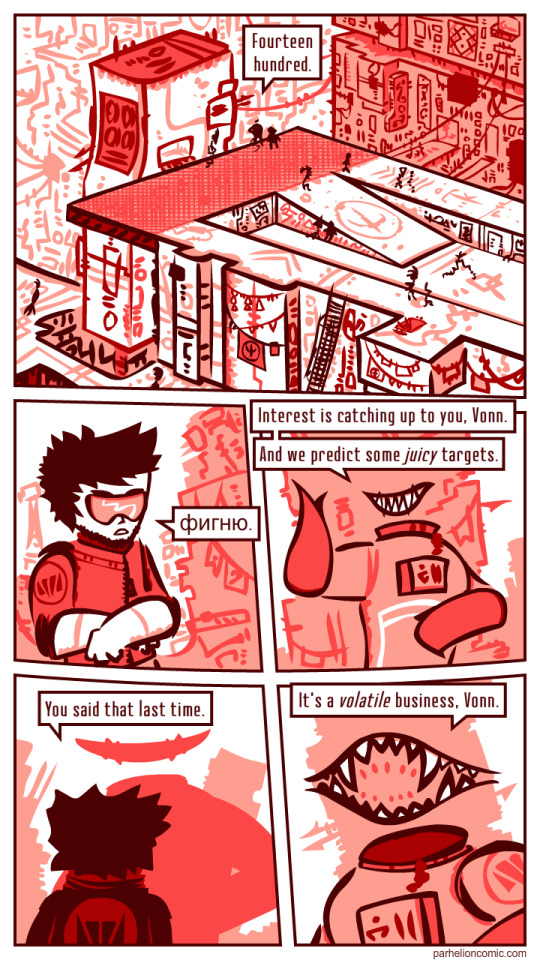
Peter meets his alien, soon-to-be partner, a translator named Cerril, at a bar. In fact, Peter interrupts Cerril's week-long alcoholic bender, mid-gargle-blaster. You see, Cerril's an ivory tower jackoff who used to work for the Collective, before it's untimely collapse just days or weeks before the story started. That's why he needs all the booze. What he didn't know is that Peter needs a translator.
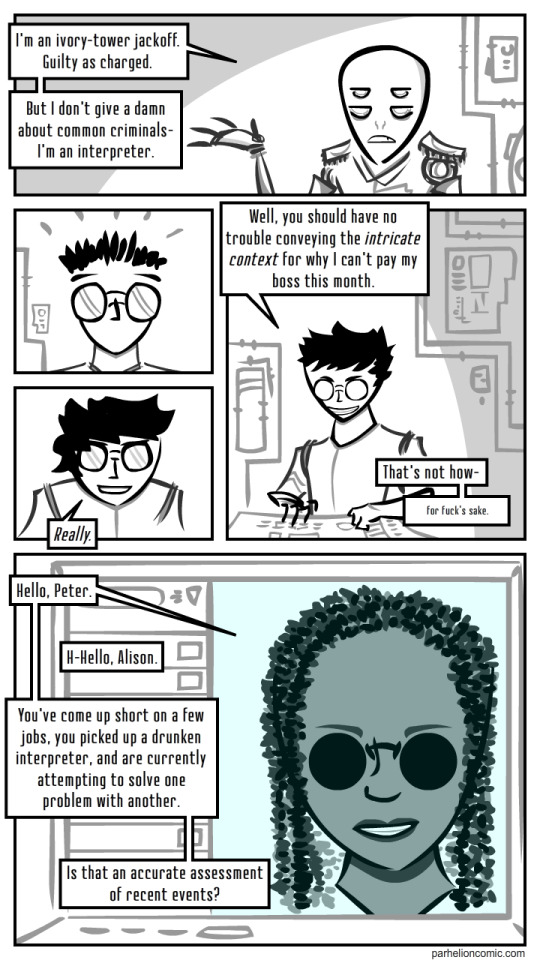
This is also a good time to point out another small problem with the art style, which is, when you use straight, perpendicular lines for your dialog balloons, especially when you're drawing in black and white, the dialog can easily get lost in the illustration, like it does at the bottom of the above page. Or it can create parallel tangents or fake panels like at the top of the previous page.
There's also a fair amount of black comedy or "gallows humor" in Parhelion, like Peter insisting to terms for his own murder, specifically that it be an involved and painful mano-a-mano affair. And Riley occasionally gets technical. Unlike Star Wars in which the function of the protocol droid C-3PO is simply assumed, Riley stops for a couple pages to explain why Cerril's job title is "translator" instead of "office clerk". Oh, but I was wrong about the Tinkertoys...
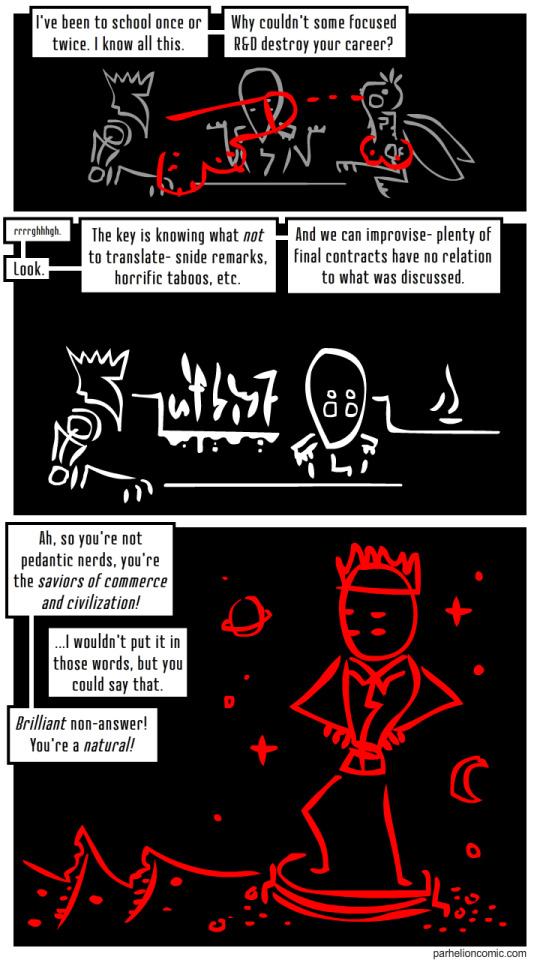
Several pages are devoted to developing the characters for Peter and Cerril before there's been any real plot. Peter presents himself as a happy-go-lucky space pirate, a kind of bargain-bin Han Solo. And it turns out that the falling-down-drunk Cerril isn't entirely cynical either.
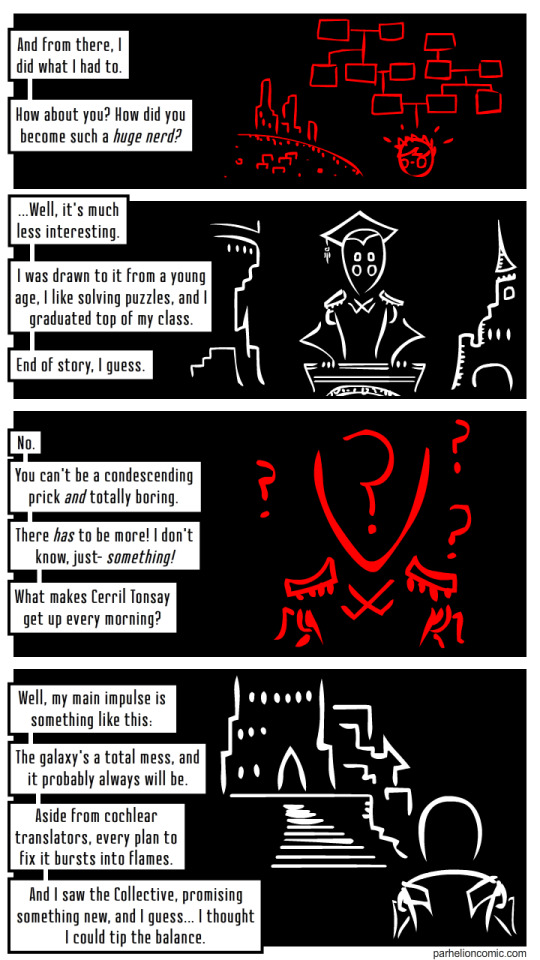
I know I sound like a broken record here, but I see a lot of what I feel is slow pacing in the webcomics I'm reviewing. Maybe it's just me, maybe I'm being a little overly critical on this point. Having said that, I'm seventeen pages in and while I've gotten some good character development for Peter and Cerril, I still haven't seen any plot development beyond "you need to bring me the translator and you can't refuse because I'm your pirate-boss and you're in deep." For reference, a standard issue of a Marvel or DC title is twenty to twenty-four pages, so if this were one of their books, we'd be on the very last couple of pages with only just the basic character development covered.
That's when we see Peter's gnarly missing-eye scar... or is that mechanical? Hard to tell.
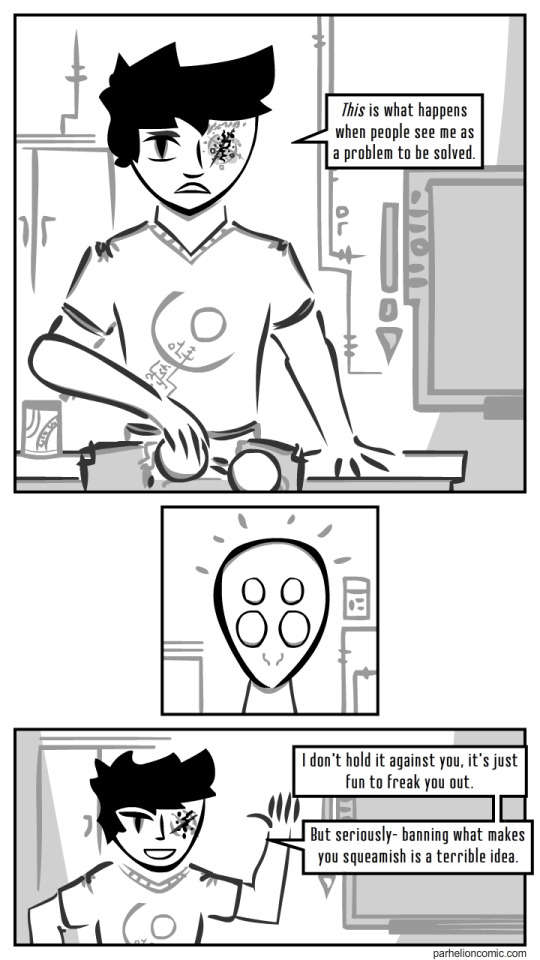
But I do think they make a good team... it's basically that bargain bin Han Solo teamed up with a drunken, curmudgeonly C-3PO.
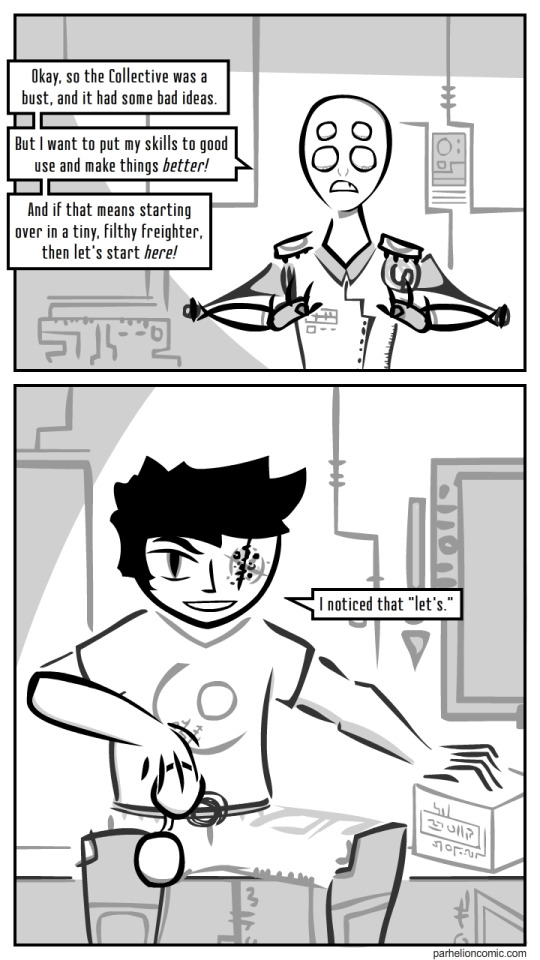
Note that in the bottom half of this page, those are supposed to be fully human, factory-direct hands, with no modifications. It's that sort of thing that makes me say I think this art style will be fairly polarizing: you'll love it or hate it, there won't be a lot of indifference. The hand on the left looks like a bunch of straw sticking out of a sleeve and the one on the right looks like a garden rake. Yeah, he's a bargain bin Han Solo, but this picture makes him look like a badass, one-eyed, space-pirate scarecrow from the land of Oz.
At the beginning of their three-day trip, Cerril asked Peter to steal something for him. By day three, Cerril finally explains that it was just some personal files he wouldn't be able to retrieve from his offices after the Collective collapsed. That's when it's revealed that these particular space pirates are gay, although that reveal is weirdly subtle and kind of sprung on the reader out of the blue like a jump-scare in a horror movie, or maybe a Rickroll. (I'm bringin' back ALL the dated memes, bae!) Pete and Cerril mention "neck marks" without any indication they had been playing tonsil hockey, although that's preceded by some peculiar seating arrangements that weren't foreshadowed in any way. So in a storytelling sense, it feels like we went from teeth-clenched teamwork to the power of love while skipping the middle part where "I'm going to murder you in your sleep, you slaver" gradually becomes "let's slip into something more comfortable".
And then they touch-down on what appears to be literally the land of Oz, right off the yellow-brick road, just outside of the Emerald City. There's even an old-fashioned hand-made crossroads sign.
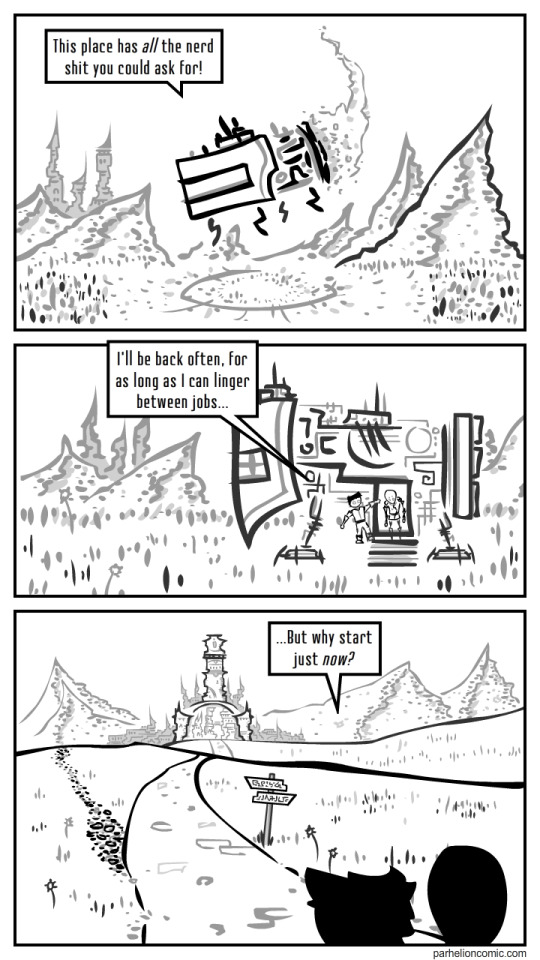
Just in time to let us know that three days alone in the ship wasn't nearly enough time for sex! Seriously, you need at least a week for a proper blowjob.
But if you thought Peter's missing eye looked painful, it's nothing compared to the hopelessly tangled earbuds that comprise the "face" of the tyrant known as the Basilisk.
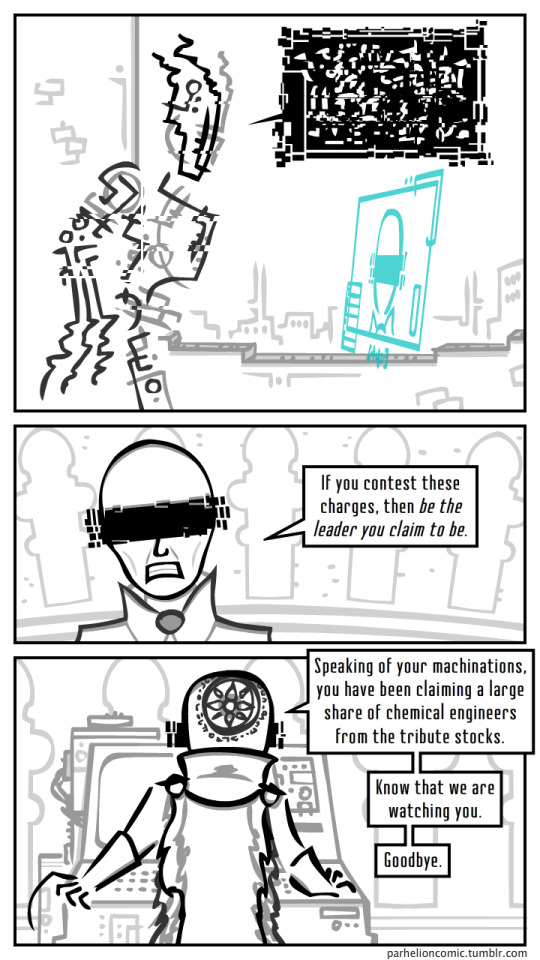
Although some of the Baroqueness is rather nice.
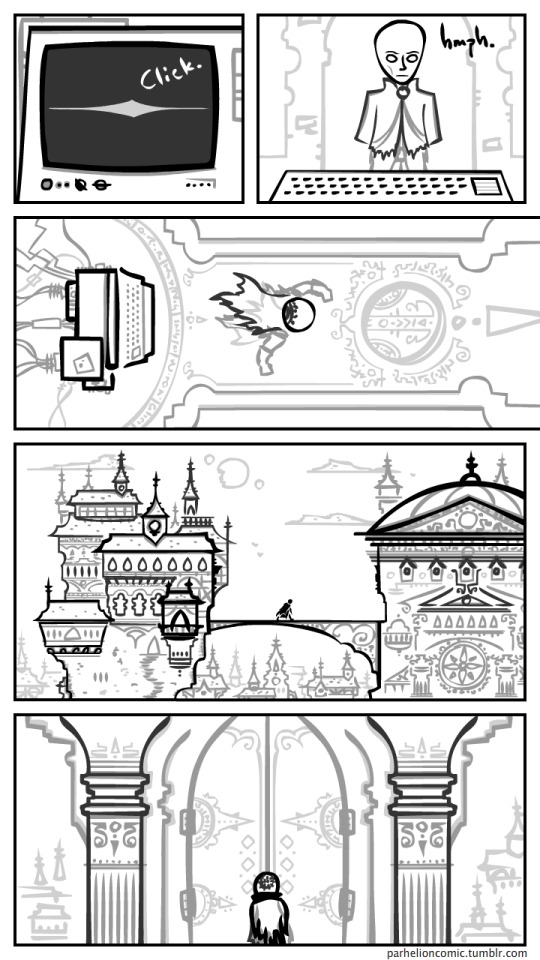
We've had a few budget cuts, so the part of Parliament's architectural columns will be played by butt-plugs. (You can't unsee it! You're welcome.)
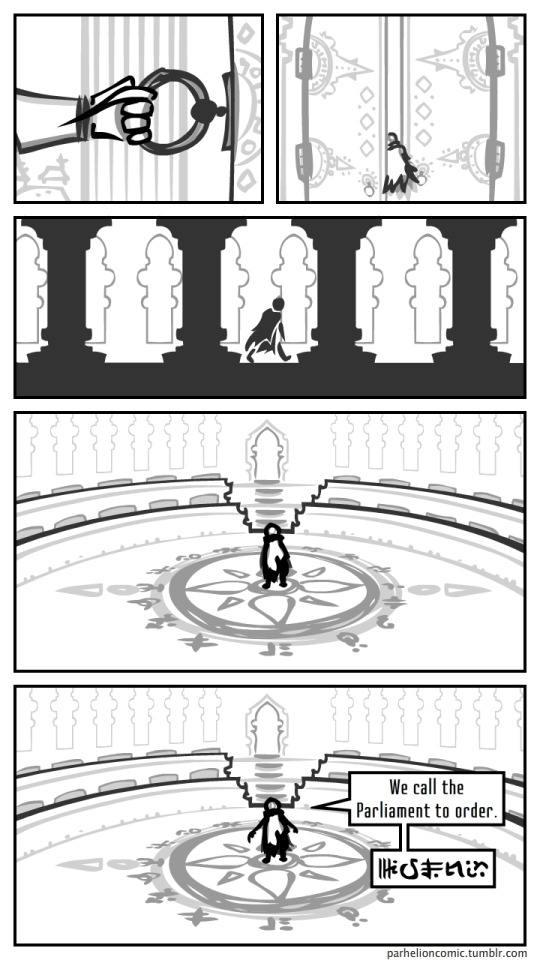
Starting in the second chapter, Riley starts getting creative with the lettering, occasionally replacing a character or two with an alien symbol. The only pattern I can see is that a particular letter or combination is always given the same symbol, so what would be "th" becomes a single symbol that vaguely resembles a J, making "the" look like "je". It's obviously not used for the purpose of censoring swearing, since the page starts with the phrase "fucking joke" (a priest, a rabbi and a minister walk into an orgy). Given that, I can only imagine that these random substitutions are purely for the purpose of adding an alien flavor to the narration or dialog of certain characters. Personally, I'm not on-board. Riley's already added some similar decoration around the dialog box, and I feel like that's the more appropriate way to create that flavor. These substitutions in the text keep interrupting my reading flow as I have to stop to workout what "video#at" or "fai#ful" mean. It's only a fraction of a second for any individual word, however even that fractional pause is noticeable and mildly irritating as a reader. Like I said, the style of this comic is experimental, and experimentation always comes with some risk and sometimes it pays off. I just don't feel like, as experiments go, this text experiment was a keeper. What do you think?
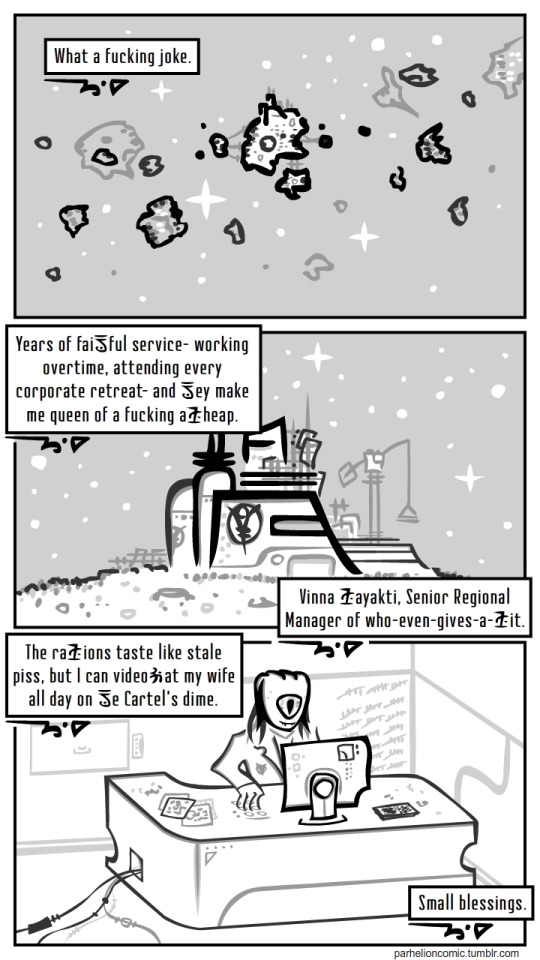
It isn't until the fourth page of chapter two that Peter and Cerril officially become partners, with a little light comedy that reminds me a little of C-3PO's pitch to uncle Owen in Star Wars IV, except that Cerril is arguing against going with Alison. (That may have a lot to do with my already saying Cerril reminds me of C-3PO.)

While the writing on this page is good and Cerril's body language is well done, the page as a whole has several trouble-spots. There are several ways the first panel could have been composed without letting the dialog cut into the top of Alison's head. While it's not hard to figure out in this particular case, dialog from a character off-camera is frequently shown as it is here in the 2nd and 3rd panel. This is problematic for a couple of reasons, one because there's no visual difference between these dialog boxes and a narration box. That's not confusing on this particular page, but I could easily see it becoming confusing on other pages. Second, and more importantly, I've seen a few more recent pages where this is done in a scene with three or more characters and it's not always apparent who's speaking. Use of colored dialog boxes or a small symbol indicating the character could resolve this issue, although as an artist myself, I would work a little harder to keep the speaking characters on-camera. I might still use the symbol on some infrequent occasions if I were having a really difficult time with the composition of a specific page. I just don't think the off-camera boxes should be a frequent occurrence... reserve them for when Dorothy finally meets the Wizard.
And on page six of the second chapter, we're finally on to our dynamic duo's first suicide mission (of many, natch). I'm pretty sure they have one of those hole-punch coupons, they get a free sandwich after every fifth suicide mission they complete. Loyalty is important, yo!

Don't worry though, the veteran Peter has a plan! Peter's plan is to show up unannounced to a definitely hostile, likely heavily armed facility, and say "Hi! I'm peter! Go fuck yourself!" Which, of course, works every time. No, seriously, nobody even mentions it being weird and they make plans with the manager of the hostile station to go get tacos later.
But Peter wants to to know you don't fuck with a space-pirate's tacos, you spineless corporate cuck!
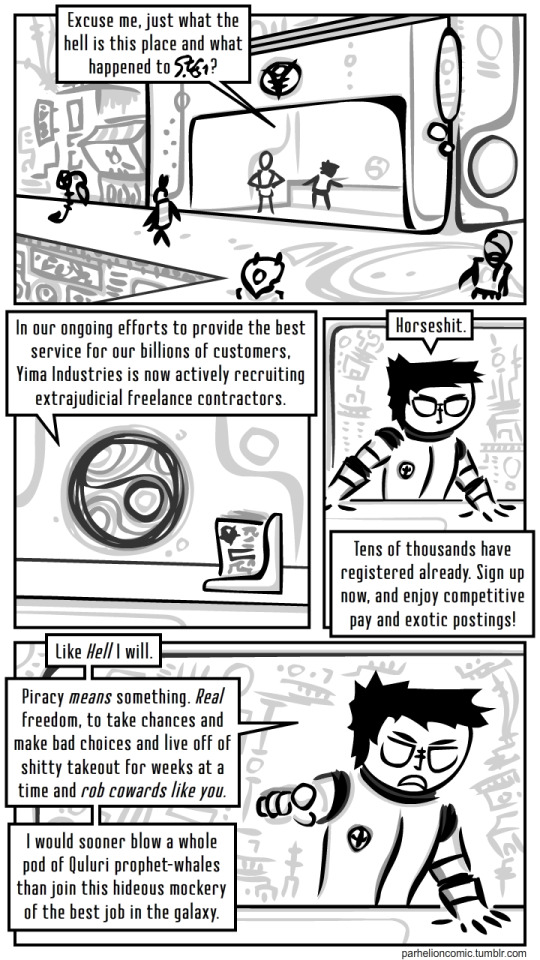
And since Parhelion is more of a black comedy than an adventure (I'm sure it's in there somewhere), this taco tirade is the big mistake where shit gets real. (Yeah, no, it's totally not lazily waltzing in on a hostile, likely heavily armed base. That part was cake.)
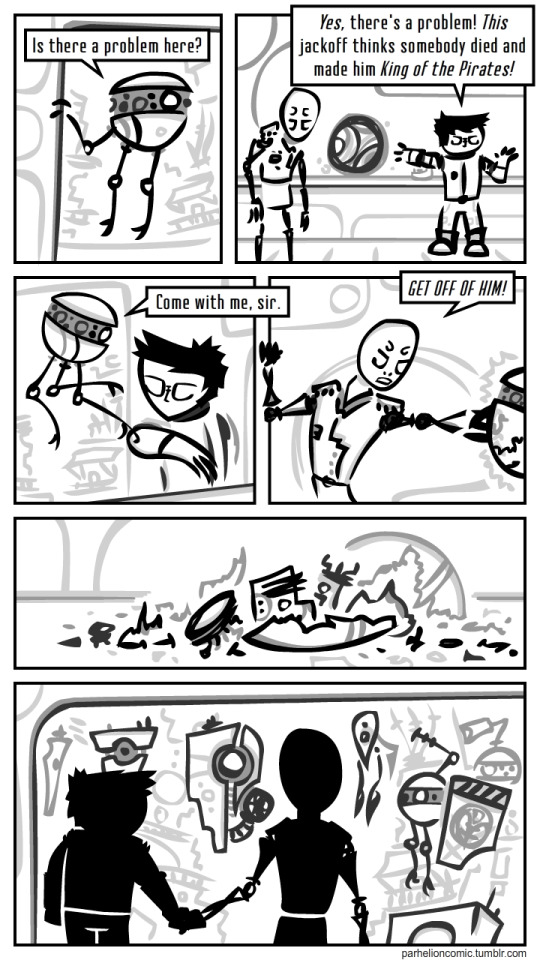
I really like that dramatic last panel on page fifteen of chapter two, so that's where I'm going to end this review.
So there's my pitch. If you enjoy tongue-in-cheek space opera, surreal and experimental illustration, and gay space-pirates, it's worth a look at Parhelion!
If you are a webcomic author and are interested in a review from me, you can check out my announcement and my review rules here.
If you enjoy my reviews and would like to help ensure I'm able to continue publishing them, you can contribute on our Patreon or if you're short on funds you can also help me out by checking out and sharing my own webcomic, Woohooligan!
Thanks! Sam
0 notes
Text
PHL / Anachronism and Liberation

Anachronism and Liberation Curated by Mary Henderson and Jane Irish August 4 - September 17, 2017 Artists’ Reception: Thursday, August 10
[Images]
Anachronism and Liberation presents nine artists, ranging from emerging to established, creating work that engages with social and/or political issues in subtle and surprising ways. The artists involved are all committed makers, whose approaches offer an expanded vision of what political art pieces that consider issues of imperialism, political oppression, labor rights, environmental justice, race, gender and sexuality can look like. The work deliberately connects to traditional practices and engages in dialog with art history; at the same time, it is powerfully responsive to the urgency of this political moment.
The show’s title refers to the notion of artists simultaneously looking backwards and forwards in their practices, employing the “anachronistic,” the aggressively handmade and historically informed, in service of “liberation,” both in the political sense of the word, and in a more personal, aesthetic sense. The artists’ connection to art history and traditions of making becomes a freeing component in their work, adding layers of complexity and allowing it to transcend beyond sloganeering or propaganda. Their art is suspended between traditional forms and liberatory meanings, in which forms of the past are celebrated, undermined, and re-construed in the effort to construct new futures. They return to traditional media with new purpose, using old resources to open possibilities for reconfigured identities, making 'nonce' forms mean something again.
New Orleans-based artist Ana Hernandez is confronted by the architecture of the oil industry on the bayous, gentrification legacies of Katrina, and the destruction of aquifer. We selected The Utica to reveal that our own region is on her mind. Ana’s compassionate reaction to ICE round-ups and fracking of central PA is one in a series Altering Internal Landscapes: In pursuit of unearthing bodies of Energy. She says that it is “a visual representation of ecological trauma; it aims to highlight the dissection and destruction of a physical and psychological landscape, whose vulnerable and shifting body print can be traced and mapped by the scars of injury left on the environment and all who inhabit it.” Ana Hernandez is a founding member of Level Artist Collective, New Orleans. She recently exhibited her work at The Contemporary Art Center of New Orleans, A Studio in the Woods, The New Orleans Museum of Art and she was a recipient of the Joan Mitchell Foundations 2016 Artist-in-Residence Program.
Roberto Lugo lets us see that Graffiti tagging and American pot throwing are connected. Lugo grew up in the Kensington neighborhood of Philadelphia. He is an American potter, social activist, spoken word poet, and educator. Lugo's work here draws together hip-hop, history and politics into formal ceramics. It is commemorative, like a 19th century Tucker Factory pitcher, but represents both an ending and a beginning, honoring the worker instead of the owner. Lugo has been featured at multiple exhibitions, including SOFA Chicago, solo shows at Eutectic Gallery in Portland, Oregon and Wexler Gallery, Philadelphia. He received the United States Artist Barr Fellowship and the Emerging Artist award for the National Council on Education in Ceramic Arts.
We admire Rebecca Ness’ activism as well as her connected artistic practice. She uses the politically charged imagery to empower both the artist and the viewer. Her work is remarkably straightforward, humorous and biting. It is both a report on our current political climate and a crystallization of a liberating feminism with a long arc. Rebecca Ness is a founding member of the web activist site, In Residence. She has exhibited at Field Projects Gallery, NY; Copeland Gallery, London; Distillery Gallery, Boston; Bergen Street Studios, Brooklyn among many others. She is currently enrolled in the MFA program in painting and printmaking at Yale University.
Odili Donald Odita orchestrates color interaction in pure and visionary leaps. Transformative routes of his palette and shapes begin as a catalog of abstract color that may signify contexts as in flags or represent the visible emanations of the exterior world, architecture of an unsettled, colonized culture. As his new formalism explores figurative historical and sociopolitical realities, his work emerges into a charged coexistence and physical presence. Odita was born in Enugu, Nigeria and lives and works in Philadelphia. He has been the recipient of grants from the McCall Foundation, Joan Mitchell Foundation, and the Louis Comfort Tiffany Foundation. In 2007, his work “Give Me Shelter” was featured prominently in the 52nd Venice Biennale exhibition, Think With the Senses, Feel With the Mind, curated by Robert Storr. He is represented by The Jack Shainman Gallery.
We experience Robert Pruitt’s portraits as a guide to peace. Pruitt draws with charcoal on paper. He selects this medium for its accessibility, its connection to the maker and hand, but also to the viewer's haptic experience: most of us have had the experience of drawing on paper. His emphatic choices of imagery from science fiction and comic books, together with the history of political and social struggle suggest that we need to change everything, to think in terms of the history of science or fantasy to guide us beyond the killing of each other. Robert Pruitt has exhibited his work at The Museum of Fine Arts Houston, The Contemporary Arts Museum Houston, The Dallas Museum of Art, The Bronx Museum of Art, the 2006 Whitney Biennial, and at the Studio Museum of Harlem. He has held residencies at the Skowhegan School of Painting and Sculpture, ArtPace, Fabric Workshop Museum, and Brandywine Printshop. He has received numerous awards including the Louis Comfort Tiffany Award, the Joan Mitchell Artist Grant, a project grant from the Creative Capital Foundation, and the William H. Johnson Award.
This small wood and paint construction by Lisi Raskin is part of a series of love tokens that the artist has been making since 2015. While the artist spent fifteen years traveling to the Arctic Circle, former East German and Yugoslav Atomic bunkers, and the American west exploring the intersection of nuclear-age fears and utopian mythologies of the Cold War, she now focuses on liberatory practices that attempt to produce and represent the occurrences in the world that she wishes to see, including radical love, collaboration across difference, and redistribution of resources. Raskin has exhibited internationally at institutions including Kunsthaus Graz, Casino Luxembourg, the Frankfurter Kunstverein, the Contemporary Art Center, Vilnius, PS1/MoMA Contemporary Art Center, the Blanton Museum of Art, the Center for Curatorial Studies/Hessel Museum at Bard College, and the Rubin Museum of Art. She has been the recipient of numerous awards and grants including the Guna S Mundheim Berlin Prize at the American Academy in Berlin, a Quimby Foundation Grant, Mayer Foundation Grant, and the Hayward Prize from the American Austrian Foundation.
Han Wang’s ceramic art presents multiple overlapping anachronisms. Wang is a Chinese artist who is living in Philadelphia, PA. Her artistic practice embodies the phenomenon she named “cultural grafting.” Her work explores the history of other cultures using Chinese techniques, and she refers to her new work as contemporary Chinoiserie. Her craft is at such a high level she is able to comment on the history of export porcelain, seduction of the copy, the autonomous artist directly articulating the misconceptions, stereotypes and bigotry with a light, freeing mirror of humor. The chickens on display in this show play with gender stereotypes as well as cultural ones, referencing both the notion of “Three Ages of Women,” and “chicken” as derogatory Chinese slang for woman. Han Wang is an artist in residence at the University of the Arts and at the Clay Studio, and has exhibited at Marginal Utility Gallery, Philadelphia and Gatov East Gallery, Los Angeles.
We see Charles Edward Williams' paintings as investigations of our inner life. Confrontation III references the human hands that display the request for trust. Concepts for this exhibit were drawn from recent and past incidents of police brutality from corrupt police officials and officers around the United States, and include the inspiration of Artist Gerhard Richter’s The October 18, 1977 series. This image is digitally manipulated from the Death of Eric Garner 2014 and used as a reference for creating the piece. This painting focuses on highlighting hands using oil paint on panel and combining elements of abstractions. This invites the viewer to be challenged and to question the relationship between the subject matter; from the reality to its abstraction. This painting is conceptually referencing German painter Gerhard Richter’s October 18, 1977 series and theoretically responding to archived incidents based on photographs of the arrests, deaths and funerals of members of the radical left-wing German terrorist gang. Recent solo exhibition of Williams’ work have been at Morris Museum of Art, Augusta, GA; Winthrop University Art Gallery, New Gallery of Modern Art \Charlotte; Central Piedmont College Art Gallery and Morton Fine Art Gallery, Washington, DC.
Alexi Worth’s subtle and coherent paintings using trompe l’oeil and cubist space are insistent on an idiosyncratic first-person point of view. A small body of work depicting the Arab Spring uprising comes from his comprehensive grasp of crucial political events and personal connections that his journalist brother Robert recently published: “The Middle East in Turmoil, From Tahrir Square to ISIS.” Alexi shares his own experience both visually and viscerally. Crafted with care and humility, the painting here establishes through a human connection to the viewer and our own efforts at freedom. Alexi Belsey Worth has had solo exhibitions with the Elizabeth Harris, Bill Maynes, and DC Moore galleries, among others. He has received awards from the Guggenheim Foundation, the Tiffany Foundation, and the New England Foundation for the Arts. As a writer, Worth’s exhibition reviews and articles have appeared in Artforum, Art in America, The Brooklyn Rail, The New Yorker, T Magazine, ARTnews, Art New England, etc. Guest Curator and Essayist: Jane Irish Irish’s work is in the collections of Philadelphia Museum of Art, Hirshhorn Museum and Sculpture Garden, and the Pennsylvania Academy of Fine Arts. Locks Gallery, Philadelphia has presented numerous solo exhibitions since 2007. She has been the recipient of awards from Pew Fellowship in the Arts, the Joan Mitchell Foundation, the Pennsylvania Council of the Arts, Independence Foundation, Creative Artist Program Service (NYFA), and the National Endowment for the Arts.
Crispin Sartwell Crispin Sartwell is a writer and philosopher, teaching philosophy at Dickinson College in Carlisle, Pennsylvania. Publications include Act Like You Know: African-American Autobiography and White Identity (1998); Six Names of Beauty (2004); Against the State: An Introduction to Anarchist Political Theory (2008); Political Aesthetics (2010); How to Escape: Magic, Madness, Beauty, and Cynicism (2014); and Entanglements: A System of Philosophy (2017).
0 notes
Text
I Tried Beer Yoga for the First Time. This is What Happened
Writer James Wagner in his first beer yoga class. (Credit: James Wagner)
July 13, 2017
Beer yoga is nearly as universal at craft breweries as IPAs: you can find a class almost anywhere.
Yoga and I had only crossed paths once before, and I walked away feeling it just wasn’t for me. But could beer yoga be different? I wanted to find out.
My Young, Inflexible Years
Writer James Wagner does beer yoga at Cairn Brewing. (Credit: James Wagner)
At a young age, I was periodically informed by childhood educators that I was not flexible enough. I was told that I did not measure up to my peers across the United States. Or at least, that is how my adolescent mind interpreted these educators’ words.
(TRAVEL: Plan Your Next Beercation)
I can also thank the Presidential Physical Fitness Test, specifically the sit and reach exercise, for those encouraging results. The sit and reach is commonly used to measure the flexibility of the hamstrings. My hammies are definitely wound like a tight yarn ball of fury.
Fortunately, throughout my adulthood I learned how stretching is essential to my survival. A little stretching here; a little stretching there. I fit it in when I remember. Unfortunately, that wisdom came at the cost of countless pulled hamstrings due to impromptu comical renditions of martial art kicks.
Yoga must be the answer.
My First Date with Yoga
A Bikram studio set the stage for my first yoga introduction. (Thanks Groupon for that stressful initiation.)
The environment was too intense for me. I played rugby, baseball, basketball and ran cross country, but this new form of intensity challenged me beyond my inflexible body could fathom. Everyone looked like a professional with their fancy spandex yoga gear. I walked in with shorts from the secondhand store and a t-shirt.
(READ: 7 Breweries Worth a Detour)
I set up my mat in the back, guided by the out-and-out fear of potentially embarrassing myself. I was constantly looking around to make sure I was doing every pose correctly. Spoiler alert: I was not.
I still had three sessions left, but I did not go back after my second visit.
Don’t get me wrong, I loved how Bikram yoga challenged me physically and mentally, but it just was not the best yoga style for a person like me. I need a pressure free atmosphere to explore stretching activities.
Beer Yoga Lures Me Back to the Mat
Two plus years and endless beer yoga ads on social media later, I find myself wanting to try yoga again. Images of beer taps, kegs and worts filled my childlike wonder and adult fantasies.
Inside the beer yoga class at Cairn Brewing. (Credit: James Wagner)
“Beer yoga must be better than studio yoga,” I thought to myself.
So I gave yoga a second chance. My goal was redemption, and of course, to avoid being a total and epic failure.
I reached out to two beer yoga instructors, Dawn Hood and Erin Sonn, for some advice. Dawn and Erin eased my fears by answering several questions; however, I was scared to ask them all. One particular question was just too embarrassing; I wanted to know if yoga could relax someone so much that they would pass gas. Looking back, now believe I likely did not pass gas during the Bikram yoga, because I was simply too tense. (Dawn and Erin, if you are reading this article, I just wanted to let you know.)
Two social media influencers of 21st Amendment Girls, Renee and Chelsea, referred me to Erin. She’s the founder and an instructor for Eat Yoga Drink. She has been a yoga practitioner for a decade but started Eat Yoga Drink in 2015. She finds that “both yogis and people in the beer world espouse creativity, community and connection.”
(READ: 3 Stories Behind Athlete-Inspired Breweries)
Not to give away the ending, but I also found this to be true.
Erin calmed my nerves by giving me a high-level overview on what to expect during a beer yoga session. She shared with me that beer yoga “cultivates mindful awareness of breath and movement.”
The expectation is to participate at a level of challenge-by-choice and then enjoy the socializing afterwards while sipping on craft beer.
These words were wise, but I needed insight from my beer yoga session hosts.
Dawn hosted my first beer yoga session at Cairn Brewing. She is also the co-founder and a teacher for Just Add Yoga. She discovered more enjoyment teaching beginners than she did actually guiding a studio session through a sequence of yoga poses. She also loves the craft beer culture.
Aha! Dawn had a brewtiful idea to just add yoga to her beer sessions with a laid-back backdrop. This infusion attracts a more diverse group of people who want to be healthy and drink beer. I am Dawn’s target audience, as well as thousands of other craft beer lovers around the world.
Say Yes to Vinyasa-Style Yoga
Contrary to what you see in many YouTube videos, Dawn and Erin’s sessions do not incorporate the beer as a prop during the yoga sessions. Many of those videos are from other countries, such as Germany, Australia and Japan. Plus, they use glass beer bottles. As a yoga novice, I choose not to push the boundaries of my flexibility and balance while holding a glass bottle full of beer. That seems too advanced and potentially hazardous. I would be scared of dropping the bottle while in the triangle pose.
Dawn and Erin both practice Vinyasa style yoga. The best way I can describe Vinyasa is one breath, one movement. I found myself gravitating towards this style of yoga rather than the Bikram style. I experienced a flow from one pose to the next. Vinyasa is truly for all skill levels. I was also pleasantly surprised that I did not worry if I was as skilled as everyone else. However, I did catch myself thinking about the beer token in my possession, laying on the floor next to my mat.
(READ: 6 Craft Beer Bars That Changed Their City’s Beer Scene)
My teacher, Emily Bond, had a calm, patient, but playful presence during the session. Her teaching incorporated beer humor and elementary teaching stories that made the whole class smile and laugh. She was even kind enough to gently correct one of my poses, so I did not struggle and fall over.
I suspect that if I had noticeably passed gas in class, I would be doing so among craft beer friends.
How to Plan for a Brewery Yoga Session
I found that combining beer and Vinyasa yoga made the whole experience more approachable. This form of yoga allowed me to relax and destress by unplugging from activities of daily living. It goes to show that craft beer can pair with anything. I have already registered for my next Just Add Yoga session at Dirty Bucket Brewing.
Beer yoga can be a great alternative for people who don’t like studios. (Credit: Kayleigh King/Moon Tiger Media)
If you love craft beer and socializing, but do not like the rigid yoga studio atmosphere, try beer yoga. If you decide to be adventurous, you do not have to do as much research as I did. Here’s my advice.
What to Expect When You are Expecting Beer Yoga
Beer comes second in beer yoga
Laid-back atmosphere
Participants of all levels of experience
A fun and helpful teacher
Beer and socializing
What to Bring
Water bottle
Comfortable and stretchy clothing
Yoga mat (sometimes they are provided)
Extra money for additional pints of beer
Namaste and cheers!
James WagnerAuthor Website
James Wagner loves to be where the craft beer culture flourishes. Luckily, he lives in Seattle and breweries are in abundance. James travels around the Pacific Northwest experiencing beer festivals and events. Hopefully, his travels will bring him to your neighborhood. Read more by this author
The post I Tried Beer Yoga for the First Time. This is What Happened appeared first on Miami Beer Scene.
from I Tried Beer Yoga for the First Time. This is What Happened
0 notes
Text
When Pixels Collide
sudoscript
Last weekend, a fascinating act in the history of humanity played out on Reddit.
For April Fool's Day, Reddit launched a little experiment. It gave its users, who are all anonymous, a blank canvas called Place.
The rules were simple. Each user could choose one pixel from 16 colors to place anywhere on the canvas. They could place as many pixels of as many colors as they wanted, but they had to wait a few minutes between placing each one.
Over the following 72 hours, what emerged was nothing short of miraculous. A collaborative artwork that shocked even its inventors.
From a single blank canvas, a couple simple rules and no plan, came this:
Each pixel you see was placed by hand. Each icon, each flag, each meme created painstakingly by millions of people who had nothing in common except an Internet connection. Somehow, someway, what happened in Reddit over those 72 hours was the birth of Art.
How did this happen?
While I followed Place closely, I cannot do justice to the story behind it in the few words here. There were countless dramas -- countless ideas, and fights, and battles, and wars -- that I don't even know about. They happened in small forums and private Discord chats, with too much happening at once, all the time, to keep track of everything. And, of course, I had to sleep.
But at its core, the story of Place is an eternal story, about the three forces that humanity needs to make art, creation, and technology possible.
The Creators
First came the Creators. They were the artists to whom the blank canvas was an irresistible opportunity.
When Place was launched, with no warning, the first users started placing pixels willy-nilly, just to see what they could do. Within minutes, the first sketches appeared on Place. Crude and immature, they resembled cavemen paintings, the work of artists just stretching their wings.
Even from that humble beginning, the Creators quickly saw that the pixels held power, and lots of potential. But working alone, they could only place one pixel every 5 or 10 minutes. Making anything more meaningful would take forever -- if someone didn't mess up their work as they were doing it. To make something bigger, they would have to work together.
That's when someone hit on the brilliant notion of a gridmap. They took a simple idea -- a drawing overlaid on a grid, that showed where each of the pixels should go -- and combined it with an image that resonated with the adolescent humor of Redditors. They proposed drawing Dickbutt.
The Placetions (denizens of r/place) quickly got to work. It didn't take long -- Dickbutt materialized within minutes in the lower left part of the canvas. The Place had its first collaborative Art.
But Creators didn't stop there. They added more appendages to the creature, they added colors, and then they attempted to metamorphize their creation into Dickbutterfly. Behind its silliness was the hint of a creative tsunami about to come.
But it didn't happen all at once. Creators started to get a little drunk on their power. Across the canvas from Dickbutt, a small Charmander came to life. But once the Pokemon character was brought to life, it started growing a large male member where once had been a leg. Then came two more.
This was not by design. Some Creators frantically tried to remove the offending additions, putting out calls to "purify" the art, but others kept the additions going.
Suddenly, it looked like Place would be a short-lived experiment that took the path of least surprise. Left to their own devices, Creators threatened to turn the Place into a phallic fantasy. Of course.
The problem was less one of immaturity, and more of the fundamental complexity of the creative process. What the Creators were starting to face was something that would become the defining theme of Place: too much freedom leads to chaos. Creativity needs constraint as much as it needs freedom.
When anyone could put any pixel anywhere, how does it not lead immediately to mayhem?
The Protectors
Another set of users emerged, who would soon address this very problem.
But like the primitive Creators, they weren't yet self-aware of their purpose on the great white canvas. Instead, they began by simplifying the experiment into a single goal: world conquest.
They formed Factions around colors, that they used to take over the Place with. The Blue Corner was among the first, and by far the largest. It began in the bottom right corner and spread like a plague. Its followers self-identified with the color, claiming that its manifest destiny was to take over Place. Pixel by pixel, they started turning it into reality, in a mad land grab over the wide open space.
The Blue Corner wasn't alone. Another group started a Red Corner on the other side of the canvas. Their users claimed a leftist political leaning. Yet another started the Green Lattice, which went for a polka-dot design with interspersing green pixels and white. They championed their superior efficiency, since they only had to color half as many pixels as the other Factions.
It wasn't long before the Factions ran head-on into the Creators. Charmander was among the first battle sites. As the Blue Corner began to overwrite the Pokemon with blue pixels, the Creators turned from their internecine phallic wars to the bigger threat now on their doorstep.
They fought back, replacing each blue pixel with their own. But the numbers were against them. With its single-minded focus on expansion, the Blue Corner commanded a much larger army than the Creators could muster. So they did the only thing they could do. They pled for their lives.
Somehow, it struck a chord. It ignited a debate within the Blue Corner. What was their role in relation to Art? A member asked: "As our tide inevitably covers the world from edge to edge, should we show mercy to other art we come across?"
This was a question each Faction faced in turn. With all the power given to them by their expansionary zeal, what were they to do about the art that stood in their path?
They all decided to save it. One by one, each of the Factions began flowing around the artwork, rather than through them.
This was a turning point. The mindless Factions had turned into beneficent Protectors.
Still No Happy Ending
Finally at peace with the ravenous color horde, the Creators turned back to their creations. They started making them more complex, adding one element after another.
They started using 3-pixel fonts to write text. A Star Wars prequel meme that had been sputtering along took a more defined shape, becoming one of the most prominent pieces of art in Place.
Others formed Creator collectives around common projects. Organizing in smaller subreddits that they created just for this purpose, they planned strategies and shared templates.
One of the most successful was a group that added a Windows 95-esque taskbar along the bottom, replete with Start button in the corner.
Another were a block of hearts. They started with only a few, mimicking hearts of life in old bitmap video games, like Zelda, before their collective took off with the idea. By the end they stretched across half the canvas, in a dazzling array of flags and designs.
And of course, there was Van Gogh.
But not all was well. The Protectors who they had once welcomed with relief had become tyrants dictating fashion. They decided what could and couldn't be made. It wasn't long before Creators started chafing under their rule.
Meanwhile, with the issue of artwork resolved, the Factions had turned their sights on each other, forcing followers to choose sides in epic battles. They had little time to pay attention to the pathetic pleas of Creators who wanted approval for ideas of new art.
The fights between the Protectors got nasty. A Twitch live-streamer exhorted his followers to attack the Blue Corner with Purple. There were battle plans. There were appeals to emotion. There were even false-flag attacks, where the followers of one color placed pixels of the opposing side inside their own, just so they could cry foul and attack in return.
But the biggest problem of all was one of the only hard rules of Place -- it couldn't grow. With the Factions engaged in a massive battle among themselves, the Creators started realizing there wasn't space to make new Art.
Country flags had started emerging pretty much from the beginning. But as they grew and grew, they started bumping into each other.
Out in the unclaimed territory of the middle of the canvas, with no Protector to mediate between them, Germany and France engaged in an epic battle that sent shockwaves through Place.
Suddenly, a world that had been saved from its primitive beginnings looked like it would succumb to war. There were frantic attempts at diplomacy between all sides. Leaders form the Protectors and the Creators and met each other in chat rooms, but mostly they just pointed fingers at each other.
What Place needed was a villain that everyone could agree upon.
The Destroyers
Enter the Void.
They started on 4chan, Reddit's mangled, red-headed step-brother. It wasn't long before the pranksters on the Internet's most notorious imageboard took notice of what was happening on Reddit. It was too good an opportunity for them to pass up. And so they turned to the color closest to their heart -- black. They became the Void.
Like a tear spreading slowly across the canvas, black pixels started emerging near the center of Place.
At first, other Factions tried to form an alliance with them, foolishly assuming that diplomacy would work. But they failed, because the Void was different.
The Void was no Protector. Unlike the Factions, it professed no loyalty to Art. Followers of the Void championed its destructive egalitarianism, chanting only that "the Void will consume." They took no sides. They only wanted to paint the world black.
This was exactly the kick in the ass that Place needed. While Creators had been busy fighting each other, and Protectors still measured themselves by the extent of canvas they controlled, a new threat -- a real threat -- had emerged under their nose.
Against the face of extinction, they banded together to fight the Void and save their Art.
But the Void was not easy to vanquish, because the Place needed it. It needed destruction so that new Art, better Art, would emerge from the ashes. Without the Void, there was no force to clean up the old Art.
And so, by design or not, the Void gave birth to some of the largest Art in the Place.
Take, for example, the part of the canvas right in the center. Almost since the very beginning, it had been one of the most contested areas on the map. Time and again, Creators had tried to claim the territory for their own. First with icons. Then with a coordinated attempt at a prism.
But the Void ate them all. Art after art succumbed to its ravenous appetite for chaos.
And yet, this was exactly what Place needed. By destroying art, the Void forced Placetions to come up with something better. They knew they could overcome the sourge. They just needed an idea good enough, with enough momentum and enough followers, to beat the black monster.
That idea was the American flag.
In the last day of Place, a most unlikely coalition came together to beat back the Void, once and for all.
They were people who otherwise tear each other apart every day -- Trump supporters and Trump resisters, Democrats and Republicans, Americans and Europeans. And here they were coming together to build something together, on a little corner of the Internet, proving in an age when such cooperation seems impossible, that they still can.
The Ancients Were Right
Reddit's experiment ended soon after. There are so many more stories hidden deep in the dozens of subreddits and chat rooms that cropped up around Place. For every piece of artwork I mentioned, there are hundreds more on the final canvas. Perhaps the most amazing thing is that on an anonymous, no-holds-barred space on the Internet, there were no hate or racist symbols at all.
It is a beautiful circle of art, life and death. And it isn't the first time in our history that we've seen it.
Many millenia before Place, when humanity itself was still in its infancy (the real one, not the one on Reddit), Hindu philosophers theorized that the Heavens were made of three competing, but necessary, deities that they called the Trimurti. They were Brahma the Creator, Vishnu the Protector, and Shiva the Destroyer.
Without any single one of them, the Universe would not work. For there to be light, there needed to be dark. For there to be life, there needed to be death. For there to be creation and art, there needed to be destruction.
Over the last few days, their vision proved prescient. In the most uncanny way, Reddit proved that human creation requires all three.
The Final Canvas
sudoscript
04 Apr 2017
(via When Pixels Collide)
0 notes
Photo

Laguna and the Arts
San Pablo in Laguna, the City of Seven Lakes, is known for its scenic beauty and timeless history. Nesting in the foothills of Mount San Cristobal and Mount Banahaw, it is an urban-agricultural community rich in plantations and aqua culture.
With its breathtaking beauty and rich culture, San Pablo, as well as the rest of the Laguna province, has been a great source of inspiration for many artists. Each town has its own unique story to tell, each nurturing a creative community in its rich artisanal tradition.
Laguna has become a premium art destination of the south we discovered that during the launch of My City, My SM, My Art in SM City San Pablo.
Paete and the Baldemor Family
Paete is a lakeside town located at the Northeastern part of Laguna, along the shores of picturesque Laguna de Bay. Founded by Spanish friars of the Franciscan order, its early inhabitants were of Malay lineage who came from Borneo in swift and sturdy boats known as balangay, made famous by skilled craftsmen . Everything about the town of Paete has something to do with the chisel. Today, Paete is known as the Carving Capital of the Philippines, and a new generation of artists have continued this tradition in carving and painting.
MANUEL BALDEMOR
Master Artist Manuel Baldemor belongs to a family of artists in Paete, a town known for woodcarving. A Filipino painter, sculptor, printmaker, writer and book illustrator, he is best known for his painting on various media that depict scenes from his hometown in simplified geometric forms with a folk art character.
He first attracted attention in the early 1970s with pen and ink drawings, capturing in meticulous detail the folk spirit of Paete. An avid traveler, he has held numerous one man shows in museums and galleries in the Philippines and overseas.
Baldemor has received several awards in the Philippines, and numerous invitations and grants abroad. He was chosen artist in residence in Chile, Estonia, France, Israel, Japan, Switzerland, , Singapore, Portugal, and most recently, in Mexico.
In October 2007, his painting titled, Karo ng Sorbetes, was instrumental in capturing a Unesco seat for the Philippines during the 34th general conference in Paris. For years, his works have been in reproduction in UNICEF greeting cards which are distributed worldwide.
MONNAR BALDEMOR
Monnar Baldemor represents a new generation of Paeteno artists, forging his own artistic path with works that call to mind the distorted figures of Spanish legend Salvador Dali, the meticulous linear strokes of German artist Ernst Degasperi, and the anatomical manipulations of the Netherland’s Hieronymous Bosch.
The son of master artist Manuel Baldemor, Monnar’s works look inward and probe the darker recesses of the soul, exploring and giving emotions that lie just beyond the realm of acceptance. Exploitation, hope, and dreams are recurring images in his forays into the mind coupled with his own metaphorical images.
ANGELITO BALDEMOR
Like his older brother Manuel, Angelo Baldemor was raised among the woodcarvers of Paete. Today, he continues to uphold his family’s - and his hometown’s - artistic tradition as a sculptor widely appreciated for his own art form, “paintures”, a brilliant three dimensional rendition and rare combination of painting and sculpture.
Angelo has added many innovations to his craft, shifting to a softer wood, batikuling, so he could sculpt fruits, vegetables and flowers in baskets and straw hats, and rice painstakingly chiseled grain by grain and then painted in their brilliant natural colors. He introduced wall sculpture to hang side by side with paintings.
Angelo’s work has brought much honor to our country – he was a Philippine representative to the Southeast Asian Tribal and Folk Arts Festival in Bhopal, India and the 2003 Inami International Wooden Sculpture Camp in Toyama, Japan.
We will get to know more about the amazing artistry of Baldemor Family featuring Manuel Baldemor, his son Monnar Baldemor and his brother Angelo Baldemor in an exhibit from March 29 to April 2, 2016 at the Atrium of SM City San Pablo. The event will also highlight the paintings and sculptures of Paete, which is the woodcarving Capital of the Philippines.
At the same time, the exhibit gathers the works of modernists and contemporary artists of Laguna. These are the exquisite brass sculpture of Carlito Ortega, the folksy story teller dolls of An Alcantara, the vibrant life like water color painting of Lito Ballaran, the dreamy contemporary works of a millennial Rodney De Guzman, that unique Filipino twist in Cubism by Pakil Artist Bernard Vista,,the Pinoy pop socio realism wood sculpture of Otep Banez, the master in the art of Philippine embellishment Patis Tesoro and the unencumbered art and immersive photography of J. Orosa Paraiso.
A celebration of Philippine visual arts- painting, sculpture, printing, photography and film making. “My City , My SM, My Art” is a joint project of SM , the Metropolitan Museum of Manila, the Shell Companies of the Philippines, and the Philippine Star with support from the National Commission for the Culture and the Arts and the Center stage Productions.
The “My City, My SM, My Art” series brings art and people together by showcasing the works of masters, modernists ad millenials around the SM Supermalls. Advocating art for all. The team works with communities to mount exhibits and key cities around the Philippines.
Joseph “Otep “ Bañez
,Joseph Bañez’s brand of Pinoy Pop Social-Realism has taken the market by storm. , making him one of the top sellers in contemporary artGrowing up in Paete, Laguna, Otep, as he is known was a “barriotic jologs”, a “teacher’s enemy number one”, and a “hari ng sablay”. He tried his luck in several fields before experimenting with painting, which he turned out to have a natural talent for.
Greatly influenced by American artist Norman Rockwell and cartoonist Larry Alcala, Otep’s works depict the daily episodes of provincial life. Folksy as his works may seem, Otep is able to find humor in these “barriotic beauties” that appeal even to human dwellers. . We will get to know more about ,Joseph “ Otep”Bañez and his realistic yet playful wooden wall sculpture as he joines the My City , My SM, My arts exhibit.
Bernard Vista
Pakil is a pilgrimage town in the province of Laguna best known for the Turumba Festival which has a seven day novena honor of the seven sorrows of the Blessed Mother. A Turumba procession, which is considered one of the longest and largest in the country, follows right after each novena.
It is in this milieu that Bernard Vista one of Pakil’s most exciting figurative artists was born, grew up, and gained recognition for his larger than life depictions of the Filipino way of life. Inspired by the rural scenes in his hometown, he puts on canvas the humble countenance of his people, humanizing the fisher folk and farmers while highlighting their passion for life, and their oneness with the bounties of nature.
Vista’s canvasses are living tableaus being acted before the viewer’s eyes – a seminal story of bountifulness, prosperity, and being Filipino. His portrayals of men and women possess that strong glimmer of indescribable peace, contentment, and strength of inner spirit.
A scholar of the Saturday Group of Artists, he is one of the founding members of the Guevarra Group of Artists He was a resident artist in the Artesan Gallery in Singapore and his works have been included in major international auctions such as the Larasati House in Singapore.
J. Orosa Paraiso
J. Orosa Paraiso grew up in San Pablo City, Laguna. A medical doctor by profession, he was based in the US for many years, but would still go back to his hometown at least twice a year, doing free neurological consultations.
J. O. Paraiso is also a self-taught visual artist who expresses himself through different mediums like painting and sculpture, and already has had solo exhibitions of his paintings in New York and Manila.Thought provoking, breath taking and full of life are just some of the few words to describe J. O. Paraiso’s art. It’s all about what we can see through his eyes.
More recently, he has taken an interest in photography. As he travels the world and in pursue of passion., he is in constant pursuit of inspiration. His series of photographs, which were shot while doing volunteer work in Bhutan were exhibited in Florence, Italy. Closer to home, he helped initiate a photography for the deaf in San Pablo City.
Lito Ballaran
Although proficient in many other media – mural, trompe – l’oeil, portraits, and animation, Lito Ballaran seems to have been born to paint watercolors.
His watercolor paintings are full of emotions and reveal a very sensitive nature. Lito has been invited to join watercolor festivals and exhibitions, and after two decades of pouring his creative energies out of the canvas of his mind, his art today reflects his emotions and feelings as he goes through life’s experiences.
With his impressive body of work, Lito Ballaran has been appointed official co representative by the International Watercolor Society for their Philippine branch. He has been actively promoting the group with the rest of the IWS Philippines team and has represented the group well in the 2015 Tam-Awan International Arts and Music Festival.
Rodney James De Guzman
At the age of ten, Rodney James de Guzman was already drawing with remarkable skill. He would later join art competitions and win prizes. There was a brief hiatus from painting when he attended college and started working. But the pull of art was strong, and it was not long when he went back to pursuing his dreams.
Rodney, who is also from San Pablo, then explored various media until he became fascinated with watercolors. He learned the required skills and techniques through practice and with the help of his mentor, Lito Ballaran, hopes to take it to the next level.
Today, Rodney’s landscapes evoke calm and tranquility. His works are like free flow of thought that represents the subtle beauty and controlled randomness. A man of few words, Rodney lets his art speak for him. What he could not say or express in words, is stated strongly in his paintings. Through his paintings, he gives us a rare glimpse of his world.
An Alcantara
An Alcantara is a sculptor who works with clay to create terracotta figures. Her clay storyteller dolls are inspired by the culture of the people of San Pablo, her husband’s hometown, a place “she has fallen in love with”. And yes, each doll has its own story to tell.
An innkeeper, writer, clay artisan, culinary history enthusiast, and zen practitioner, An, whose initial love is writing and storytelling, is delighted that through her dolls, she can write a narrative without using the words she was used to during her days in publishing.
Today, An works with some out of school youth, single mothers, and members of the community to make her storyteller dolls with a unique Filipino spin on hand-pinched, hand painted clay.
Carlito Ortega
Carlito Ortega is a sculptor who works with welded steel and brass, creating figurative works inspired by Philippine folk art in both intimate and monumental scales. Most of his sculptural pieces are heavily influenced by his experiences growing up in rural Bukidnon. His figures are characterized by exaggerated body positions to amplify the sense of movement.
For Carlito, the process of creating bronze figures is an emotional, intuitive process. It begins with the heart as he rarely plans the figures he creates. It is about molding the metal sheet into what it calls to be. This is also why Carlito does not create replicas of his statues. They are all one of a kind. Each one sharing a story of Carlito’s soul at that moment.
Patis Tesoro
Patis Tesoro is an artist and fashion designer, social activist and heritage conservationist, entrepreneur and lifestyle icon. Bursting with creative energy, she has used her artistry to protect and assert what it means to be Filipino.
In the 1950s, she learned from her mother Nena Fabella Pamintuan, a stylish woman of means, who was a kustorera (or a dressmaker) in post-war Iloilo. After her high school classes at the convent school Assumption in Iloilo, Patis learned to embroider, thus opening her eyes to the intricacies of the craft and the art of embellishment.
Ms Patis Tesoro’s interpretation and adaptation of the Filipiniana to current fashion trends has earned for her various recognitions and awards. She is an advocate of bringing out the best in Filipino artistry- from her embroidery, fiber, woodworks, sketches and drawings- showcasing the artistic Filipino heritage that the rest of the world came to admire..
Today, she has pushed toward more artistic frontiers by creating what she calls Bohemian Filipiniana, this time using more flamboyant colors and designs all of which can also be seen in her drawings. Her drawings masterfully exemplify her profound passion for detail. And her trademark baroque patterns.
0 notes
Text
Optimisation is the enemy of creativity in marketing and music
No, you are not becoming crankier as you approach middle age – music is indeed getting worse every year. And the marketing industry’s obsession with optimisation is to blame.
In late 2017, the YouTube channel Thoughty2 published a video exploring how music has changed over the decades. After starting with The Beatles, the narrator continues with an example of classic British understatement: “Fast forward to 2010, when Justin Bieber released his hit single Baby. This is generally considered to be a bad move.”
According to the research in the video, lyrical intelligence, harmonic complexity, and timbral diversity have decreased while dynamic range compression has been used to make music louder and louder. In short, songs are becoming stupider – especially since every hit now includes the “millennial whoop” as well.
“Instead of experimenting with different musical techniques and instruments, the vast majority of pop music today is built using the exact same combination of keyboard, drum machine, sampler, and computer software,” Thoughty2’s narrator states. “This might be considered as progressive by some people, but it truth it sucks the creativity and originality out of music – making everything sound somewhat similar.”
As a rule, businesses do not like risk. The video states that record companies today must spend anywhere from $500,000 to $3m to sign and market a new artist. That is a lot of money to spend on a band without being fully confident of success.
To minimise the risk and maximise the potential return, these companies optimise the music to do whatever seems to have worked in the past. Same set of instruments? Check. Simple lyrics? Check. Is it loud? Check. Simple melody? Check. Can you dance to it? Check. Millennial whoop? Check check.
But that optimisation process is a downward spiral that will result only in songs that will make Rebecca Black’s Friday sound as brilliant as Led Zeppelin's Kashmir. It is creating music by paint-by-numbers. It is ticking boxes rather than being creative. And the same thing is occurring in the marketing industry today.
The rise of optimisation
After my first career in journalism years ago, I went into marketing and at one point met with a recruiter who was looking for a digital marketer. “I need an expert in SEO, ASO, and SMO,” she told me, further rattling off a lengthier list of random acronyms.
“Optimisation” became all the rage after companies discovered in the 2000s how much traffic websites could attract from search engines. After the birth of search engine optimisation (SEO), marketers tacked on the latter word to create “app store optimisation” and “social media optimisation” as well as countless other uses where the term also made little sense.
App store optimisation (ASO) looks for hacks to increase a mobile application’s ranking and findability in places such as the Google Play Store and Apple’s App Store – rather than, you know, creating and promoting a real, useful app that people will like. Social media optimisation (SMO) is a useless term because social media is simply a set of channels and tools that can be used for any specific promotion tactic.
Now, businesses have always discussed general best practices. My last job in journalism in the 2000s was serving as the editor-in-chief and executive director of the Boston non-profit newspaper Spare Change News. (It is one of the newspapers in the United States that are modeled on The Big Issue in the UK.)
In that role, I once attended an annual convention of the North American Street Newspaper Association that was held in Halifax, Canada. There, the assembled staffers discussed the best practices in terms of pricing, circulation, and countless other topics. Today, marketers talk about optimisation, which often means the best practices in line with someone else’s algorithms or what has purportedly worked for others.
Buffer has published studies on the ideal lengths of everything from blog posts to tweets to headlines to Facebook updates. HubSpot has reported the best times to post on social media. But in the end, both best practices and optimisation come down to the same thing: doing what everyone else is doing.
The perils of optimisation
Once, I was in a meeting where people were discussing how to get more traffic from blog posts spread on Facebook. The ideas focused on using psychology and gaming the social network’s algorithm: “Let’s ask people to comment on posts to increase engagement!” and “Let’s change the posts so that they are lists whose headlines start with numbers!”
“Make a funny, creative video advertisement instead,” I suggested, noting the reach that humorous videos receive on Facebook. But no one listened. Everyone cared so much about optimising the form of the creative that no one thought about the creativity of the creative. They prioritised the form over the function.
The perfect example of this is when marketers see studies on which headlines get the most “engagement.” In June 2017, Buzzsumo analysed 100m headlines and found this information on which headlines receive the most clicks, “likes,” and shares on Facebook:
Too many digital marketers use such information and focus on producing whatever marcom is cheapest and then optimising it. Here is a sample of recent blog posts on Medium from a certain prolific marketing writer:
5 Strange But True Habits of the World’s Richest People
5 Smart Reasons to Create Content Outside Your Niche
5 Simple Hacks to Sharpen Your Emotional Intelligence
10 Insanely Good Reasons You Should Publish On Medium
3 Unusual Hacks to Completely Up Your LinkedIn Game
Bored now.
Too many marketers go overboard and focus on optimisation to produce rubbish marketing such as clickbait blog posts with the same headline format such as this: [number] [unnecessarily strong adjective] [noun] to [achieve some goal].
The internet will continue to be flooded with boring, optimised posts that all have the same title formats in an effort to get clicks or satisfy other short-term metrics. But optimisation is the enemy of creativity and leads to worst long-term results. (Just look at how many reboots of successful TV shows from the 80s and 90s have failed today. The studios likely thought that copying what was done before would guarantee another success.)
Redundant optimisation quickly becomes cliched, hurts the brand, and is obvious to consumers. If Oxford Academic were to title journal articles in the above manner, the Oxford brand would become laughable. The only way for BuzzFeed News to be taken seriously – and the publication is indeed doing excellent journalism – has been to decouple its brand from the notoriously clickbait parent company.
Optimised reflects only short-term thinking. Using clickbait to get people to a website is the same as knocking people over the head and dragging them into your store. They may be there, but they will not buy anything because they will hate your brand.
When everyone optimises for everything, it is no longer a competitive advantage. The only true competitive advantage that people will have is what rests in their brains – creativity. Without that, you will only be as good as everyone else.
The benefits of creativity
According to an updated study in Admap magazine by Data2Decisions founder Paul Dyson, creativity is – by far – the second-best profit multiplier after market size:
Optimisation and best practices aim to do what someone else defines or the best of what everyone else does – but nothing more than that.
"Best practice is like training wheels – it keeps you safe whilst you're learning how to excel in your industry,” Helen Pollitt, head of SEO at the British digital marketing agency Reflect Digital, said. “To really differentiate yourself from the competition you need to be open to experimentation and growth, true optimisation requires facing failure. The issue with sticking to the safe zone of best practice is it stifles creativity."
The best depiction of the benefit of being different that I have seen comes from this BBH ad:
People notice what is different. And if your marketing does not get noticed in the first place, nothing else you do matters. As BBH London strategy director Lucian Trestler recently put it:
“‘Difference’ isn’t just a two bob philosophy or a frivolous creative penchant. It is the most powerful communications tool there is to deliver commercial results. We have a vast amount of data to support that. Evidence from neuroscience, marketing science and creative effectiveness data all agree on this point; difference is commercially safer than ‘safety.’”
Optimising based on data or algorithms is easier than being creative – but it is not always better, according to Wistia co-founder and chief executive Chris Savage.
“Today, everyone scores their leads with Marketo and A/B tests thirty different varieties of their landing page. You can’t get a competitive advantage doing that stuff anymore. You could say that as the percentage of marketers with a certain tech stack or using a certain tool approaches 100%, the competitive advantage you reap from it approaches zero,” he once wrote. "Using data to scale your marketing is critical. But when we all have access to the same types of data, it won’t be the data that differentiates us — it’ll be the art.”
Tom Goodwin recently said something similar: “A/B testing seems to be getting out of hand. Seems to be a way to offload decision making, not have a strategy, or gut or courage. What great art/music/products would ever be made this way?”
But tell that to those digital marketers who think only in terms of optimisation. Tell that to high-tech chief executives who want to mimic the marketing of competitors and think that they need only a differentiated product to be successful. (Just like record companies, startups are risk-averse because they do not want to lose the millions of investor dollars.)
In a quote attributed to John Ward from B&B Dorland in England, “advertising is a craft executed by people who aspire to be artists but is assessed by those who aspire to be scientists. I cannot imagine any human relationship more perfectly designed to produce total mayhem.”
At Digital Annexe University in 2015, Dave Trott gave a classic speech on creativity. Effective communications, he said, needs to have an impact, needs to communicate, and needs to be persuasive. “Impact” is the most important part.
“Impact will get you on the radar,” he said. “Without impact, there’s nothing there. There might be a bloke outside on the street right now telling us the secret of all life, and we’ll never know because we can’t hear him. Without impact, nothing happens.”
Now, take the desire of so many marketers to optimise all collateral to match some alleged universal standard. How will their work be different from that of everyone else? How will their work stand out? How will their work have an impact?
“Optimisation might work for certain businesses for a certain amount of time,” Steve Daniels, an independent graphic designer in the UK, said. “This course of action may feel safer, but it only remains safe if there are no competitors who disrupt the market or start playing the brand game in a strong way. As soon as that happens, focusing on creativity is a great a way to play the long game – and to invest in your future success.”
If your business wants to remain safe, no one will notice you. Taking creative risks is how you become memorable.
A quick recommendation
So, if you want to listen to an album where the musicians wrote their own material, played dozens of instruments, and created songs that are lyrically intelligent, harmonically complex, and timbrally diverse, I have an assignment for you.
Listen to records or remastered CDs of the Moody Blues album In Search of the Lost Chord (1968) and The Smiths’ song How Soon Is Now? (1985) with a good pair of noise-cancelling headphones and some refreshment of your choice. Maybe it will kickstart some creative inspiration.
After all, the Beatles will be remembered forever. Justin Bieber will not.
The Promotion Fix is an exclusive biweekly column for The Drum contributed by global marketing and technology keynote speaker Samuel Scott, a former journalist, consultant and director of marketing in the high-tech industry. Follow him on Twitter. Scott is based out of Tel Aviv, Israel.
This content was originally published here.
0 notes